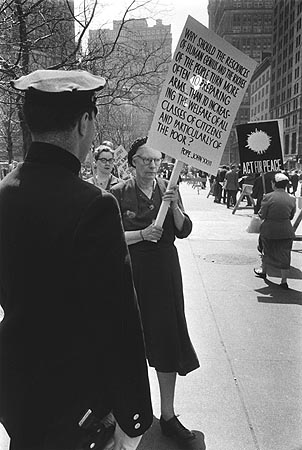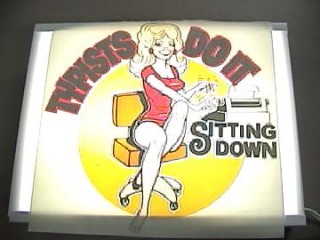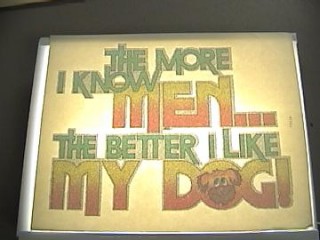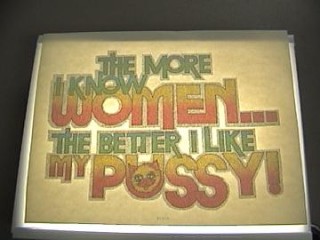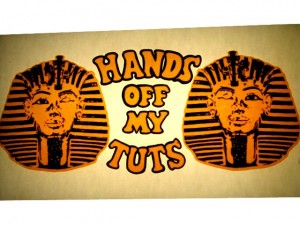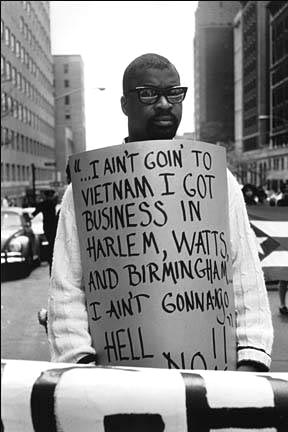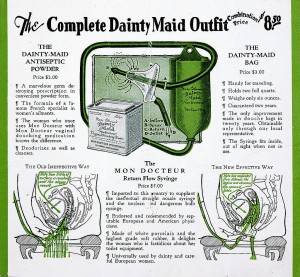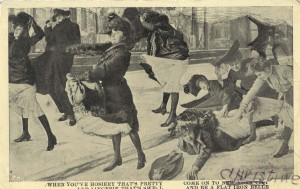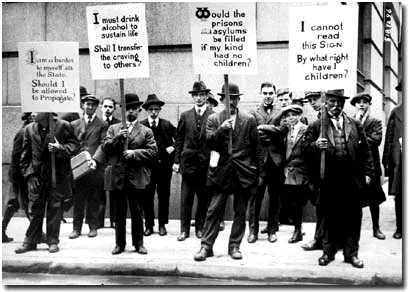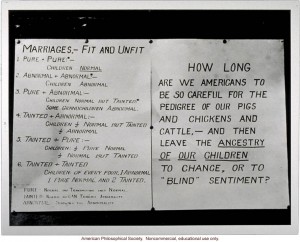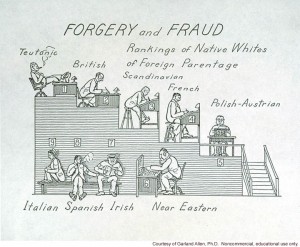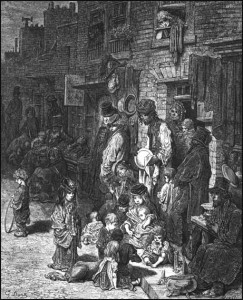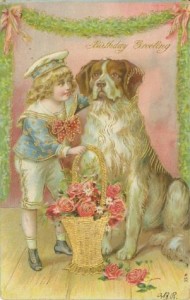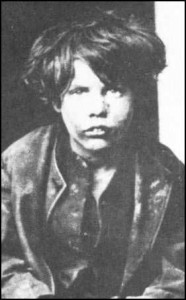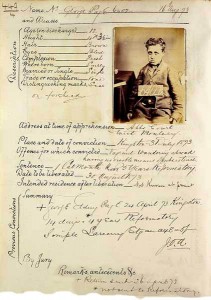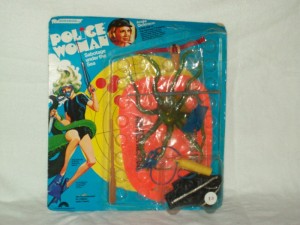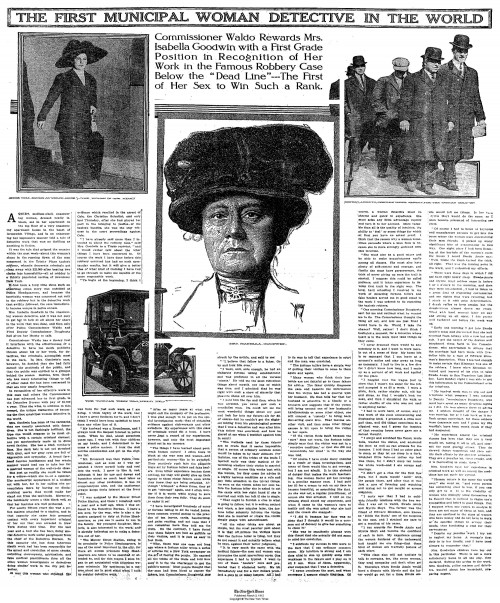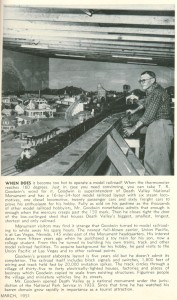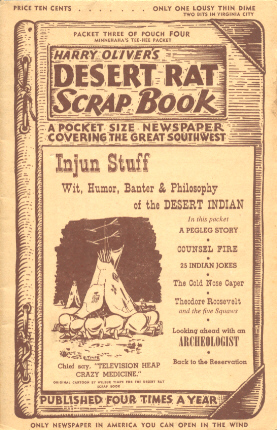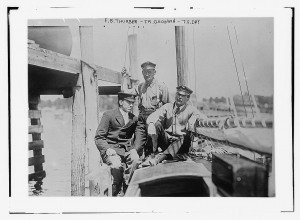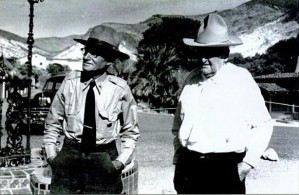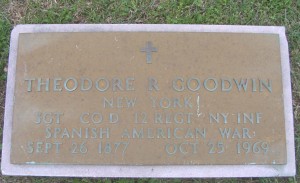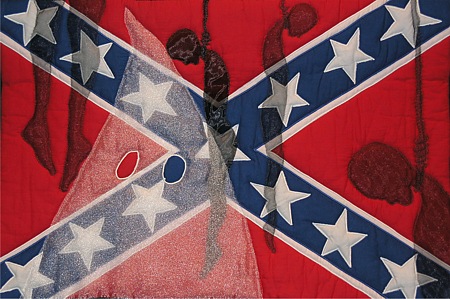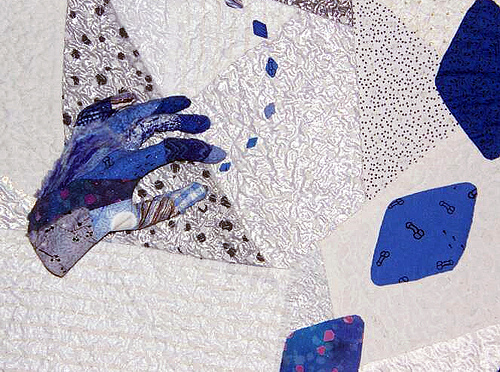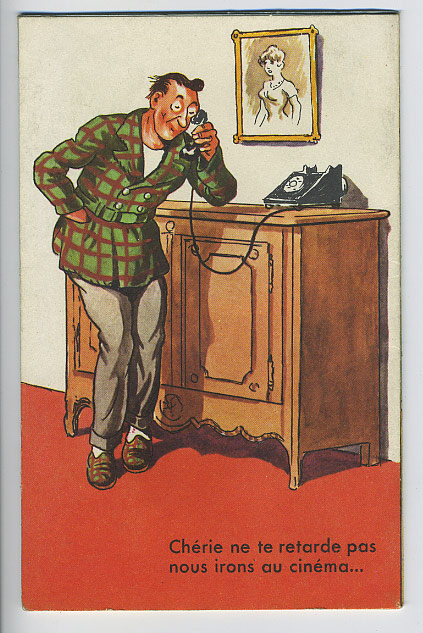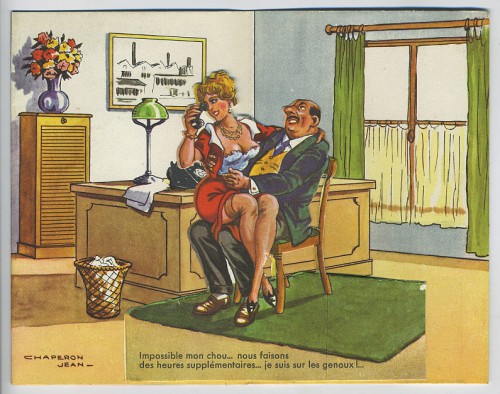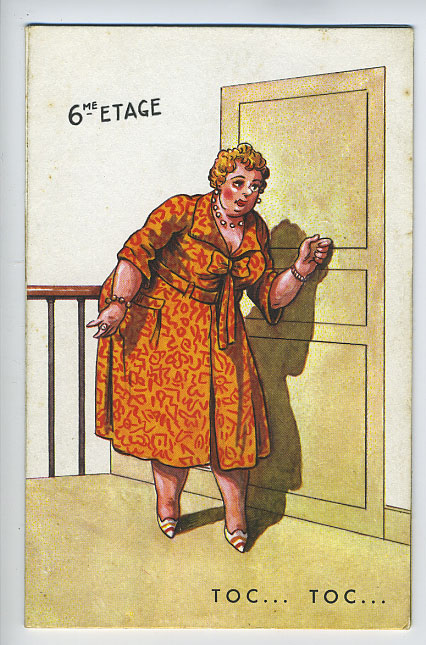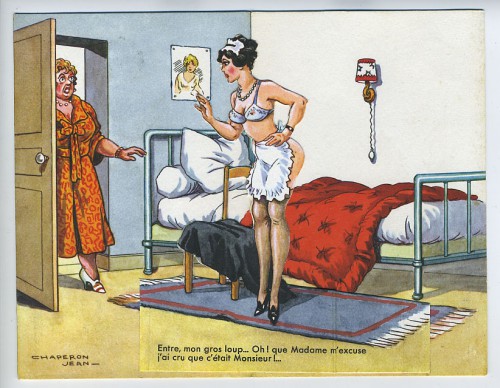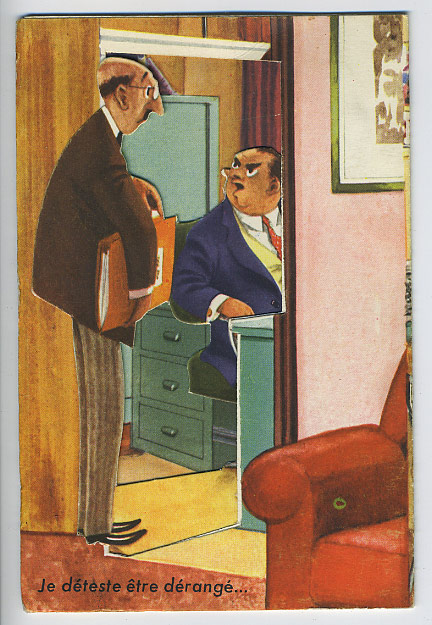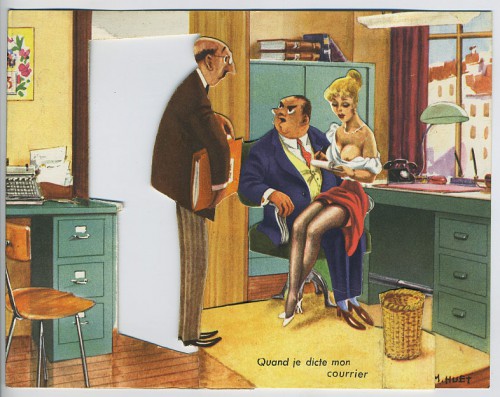Vivian Cherry photograph of Dorothy Day, founder of the Catholic Worker newspaper, picketing against the Atomic Bomb, New York, 1959.
Tag: culture
Remembering Retro Risque T-Shirt Iron-Ons
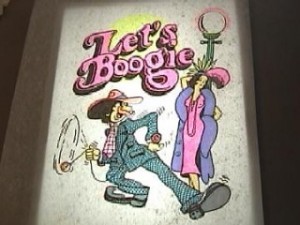 Back in the day, you couldn’t go to a mall and avoid a visit to (or the smell of) the t-shirt shop.
Back in the day, you couldn’t go to a mall and avoid a visit to (or the smell of) the t-shirt shop.
There you could select your t-shirt style (ringers were de rigueur, but then the baseball shirts with contrasting sleeves came in — oooh!), get your size, choose a color, pick out the funkiest iron-on, and even have it all personalized with letters (including glittery & puffy versions) spelling out your name.
Ah, those were the days, my friend…
Sure, now you can use your computer to design your own graphic and print it out at home on some iron-on paper and iron it on yourself (if you even own or can find your iron), but it’s not the same.
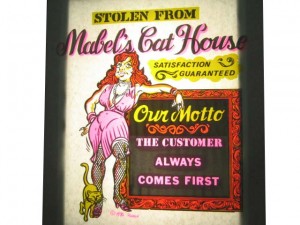 Don’t argue with me; it’s not the same, I tell you!
Don’t argue with me; it’s not the same, I tell you!
The 70’s were the Golden Age of Iron-Ons.
There were rock iron-ons, iron-ons with drug references and slang (that you had to be cool to ‘get’) — all sorts of stuff.
But the best, the most memorable, were the risque & down-right lewd t-shirts which had designs running the polarized gambit of responses to women’s liberation. You had sexist men, trying to exert their dominance through sexual bravado, sometimes cloaked as jokes, one one end; and on the other end, women trying to make their point that they were equal & could be dirty too.
I’m not sure that Typists Do It Sitting Down was exactly liberating or showing support of the ERA (more likey to feed the naughty secretary mythology), but, hell, they were worn by the libbers at PTA meetings — I mean literally worn at PTA meetings.
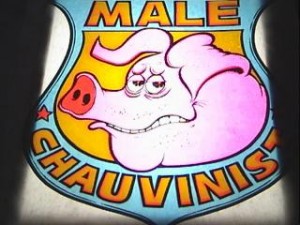 Sometimes a chauvinist pig & a demonstrating libber had on the same shirts. Was “Sex is Like a Bank Account, as soon as you make a Withdrawl, you lose Interest” supposed to be sex positive? Or was it ironic? You didn’t always know…
Sometimes a chauvinist pig & a demonstrating libber had on the same shirts. Was “Sex is Like a Bank Account, as soon as you make a Withdrawl, you lose Interest” supposed to be sex positive? Or was it ironic? You didn’t always know…
I’m pretty sure a lot of the adults wearing them didn’t know either.
It was confusing.
I’m sure part of the reason so many of these iron-ons and finished tees were seared into my brain as if the press-iron had melted the plastic goo-graphics into my brain had a lot to with my age.
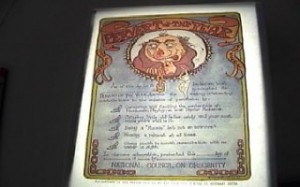 Being a teen-aged girl standing behind a guy who’d just made/bought a “mustache rides” tee — who smiled at you just a little too long — makes you understand the classless menace even if you don’t know what that sort of ride is… And then, when a friend’s older sibling tells you what it means, you die another special little death.
Being a teen-aged girl standing behind a guy who’d just made/bought a “mustache rides” tee — who smiled at you just a little too long — makes you understand the classless menace even if you don’t know what that sort of ride is… And then, when a friend’s older sibling tells you what it means, you die another special little death.
Ah, good times.
But what’s really surprising is to look at what’s left of these original retro iron-ons and realize just how many you don’t understand. It’s not just that I don’t recall seeing them before; I honestly don’t understand them.
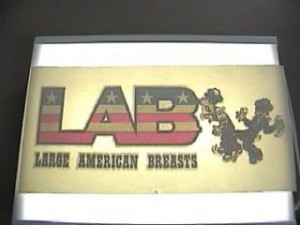 Like “LAB Large American Breasts” — was that for men or for women? The nipples on the ‘B’ indicate, a large American no. And was “LAB” supposed to be a parody of another LAB? The League of American Bicyclists? The Liberation Army… Uh. I don’t know.
Like “LAB Large American Breasts” — was that for men or for women? The nipples on the ‘B’ indicate, a large American no. And was “LAB” supposed to be a parody of another LAB? The League of American Bicyclists? The Liberation Army… Uh. I don’t know.
Maybe it’s just as simple as men boasting they wanted big breasted women & I’m over thinking it.
But what about this? If “The more I know MEN… The better I like my DOG” was an iron-on for woman to wear, does that mean “The More I Know Women… The Better I Like My PUSSY!” was for men? Um, that iron-on doesn’t really transfer — the concept, I mean (I’m sure the image went/goes on a shirt fine). …There aren’t any rainbows or triangles to signify any LGBT significance.
Maybe I’m just too obtuse. Or too cerebral… This was the 70’s. I probably shouldn’t expect a lot.
But I want to add these iron-ons to my collection. That way, as usual, I’ll have some time to ponder the individual messages and their part in the collective message — and maybe that will help me make more sense of it all. Maybe.
Signs Of The Times: 1968
Photograph by Steve Schapiro, New York, 1968.
As an ephemera collector, I can’t help but wonder… What ever happened to that sign?
Did Margaret Sanger Sell Dainty Maid Outfits?
First my disclaimer: I sadly do not own this old advertisement & instructions for the “Dainty Maid Outfit” (douche bag, antiseptic powder, and syringe); I found it while searching at the Library of Congress for photos of Margaret Sanger for the eugenics post.
The reason I didn’t include it then & want to discuss it now is two-fold.
One, there’s some confusion over Sanger’s connection to the item.
While the LoC notes that this paper, published between 1900 and 1930, was part of Sanger’s collection, saying, “Like many of her contemporaries, she retained all kinds of printed matter accumulated during her career, including pamphlets like this one relating to women’s gynecological health and hygiene,” it’s not entirely clear that this is the end of the antique ephemera’s story.
In 2006, the Margaret Sanger Papers Project (MSPP) reported this (links added by moi):
In his recent book, Men of Tomorrow: Geeks, Gangsters, and the Birth of the Comic Book (New York, 2004), author Gerard Jones highlights the role played by the poet and editor Harold Hersey in the pulp publishing industry. Hersey, one of Sanger’s lovers in the late 1910s, later wrote an unpublished biography of Sanger. He worked closely with Sanger in the early days of the Birth Control Review. “We didn’t only sell magazines,” Jones quotes Hersey as saying, “but also razor blades and other items.” “The ‘other items’,” Jones explains, “were contraceptives. Sanger was not only a proponent of birth control but a mail-order dealer, with her own line of condoms, diaphragms, and ‘Dainty Maid’ douche kits.” That is new information to us. Sanger was always extremely careful never to associate with the commercial trade of contraceptives. Her opponents often accused her of profiting from her cause, but there has never been a shred of evidence she received money for selling birth control or taking part in a mail order business – under or above ground. It is possible that one distributor of the Review, Eastern News, used its sales network to send illegal publications, condoms and liquor around the country, but most likely Sanger had no knowledge of it. For his sources, Jones cites Hersey’s autobiography, Pulpwood Editor, which does not mention the mail order venture, and unspecified collected material by Michael Feldman, a researcher on the comic book business. Thanks to Professor Ed Shannon for bringing this one to our attention.
However, there was a 2007 release The New Pulpwood Editor also. And, despite claims to Hersey’s “unpublished biography” of Sanger, others claim to have a copy. All of which not only further confuses things in terms of what source was used, but leaves the accuracy of Hersey too far down the pecking list at this point to even verify it.
But regardless of the characters involved & their individual characters regarding telling tales (& proper documentation of sources), how can the MSPP claim Sanger’s ignorance to The Dainty Maid Outfit when the LoC has it — and in their Margaret Sanger collection (Papers of Margaret Sanger, container 252) yet?
The second reason I brought this vintage female hygiene ad up separately should be apparent: researching is not for the timid, not the easily exhausted.
If this was a product Sanger offered via mail order, then perhaps The Dainty Maid was more than a cleansing douche… Contraceptive products, illegal at the time, were sometimes sold with the word “French” used as a secret code to communicate the “illicit” purposes of the product; either to wash away sperm post-coitus or perhaps even the “antiseptic powder” was even a spermicide.
The “What Happened To You?!” Musical Family Road Trip
 On Monday we drove from Fargo (ND) to Menomonie (WI) to meet my folks and get the eldest who had spent a week at their house. We do road trips like this quite often, what with visitation & all, so what I’m about to say happens in many variations…
On Monday we drove from Fargo (ND) to Menomonie (WI) to meet my folks and get the eldest who had spent a week at their house. We do road trips like this quite often, what with visitation & all, so what I’m about to say happens in many variations…
Somewhere around Hudson (WI), hubby and I put in a CD. Not just any CD, Pete Seeger’s For Kids & Just Plain Folks (a recent garage sale find). He & I begin to sing along and either our collective loud singing or my “chair dancing” garners interest from the children. We are notified by this when Hunter complain-asks, (with intensely wrinkled face), “What is this?!” I tell him it’s folk music; that I like bluegrass and folk music. His response?
A judgmental, “What happened to you?!”
But eventually, the children not only listen (which required two of three to remove earplugs & turn off their iPods) but begin singing along — even to songs they’ve never heard before, like the fanciful & silly Here’s To Cheshire — Here’s To Cheese (Froggy).
As Pete Seeger himself said in his narration, there once was a time when very few people had music to listen to. Only the very rich could hire performers, so most people had to make their own music. (In his narration, Seeger relays the comments of a man who claimed to have learned the fiddle because he noticed that fiddle players got to stand next to the fires; which prompted me to add, “And fiddle players get the chicks.” To which hubby commented, “Fiddlechicks!” now a frequent expletive we use lol)
Anyway, my point is that most of us are spoiled by the availability of music — and we lessen the musical experience too. Not only do we make less music ourselves, but we don’t share it either. We sit enclosed in our own musical bubbles, earphones in and isolated from the experience of sharing music. For hours. Days, even.
It’s a shame, for there’s great fun in sharing a silly sing-along with Seeger. Or, as occurred later, singing along with Three Dog Night – Joy to the World: Their Greatest Hits.
I must say that those 80’s air band contests (yes, I “competed” in those) & Karaoke (even though they are much more solo-performance oriented) are better alternatives to the isolation of listening/singing alone to your earplug-fed music, with or without singing into your hairbrush. (But Rock Band et all can go to hell; it’s not teaching a love of music or even a shared musical experience, just making music more competitive acts and solo pursuits.) I’m much more in favor of group & family sing-alongs — be they with Mitch (grandma put those albums on at Christmas) Seeger, Three Dog Night, GNR, or whoever.
So take a road trip with your family, your girlfriends, etc. Have everyone unplug from their individual listening devices, & create a sing-along.
You could try this at home; but just like those questions kids ask you when you are driving, you have a captive audience in the car. Use it.
Credits & Other Info:
Mini review of Pete Seeger’s For Kids & Just Plain Folks: A lovely collection, but poorly equalized. I suggest other Pete Seeger recordings where the volume doesn’t waver, resulting in continual volume adjustments & ear-blasts. (However, as usual, not all the songs may be available on other CDs/recordings; I’m not into researching that.)
Mini review of Three Dog Night – Joy to the World: Their Greatest Hits: Absolutely fabulous! Has 14 songs which sound like they’re on vinyl, and has a track (I’d Be So Happy) that’s not on the other (later released) 20 Greatest Hits album.
Image made via CustomRoadSign.
Ephemera Really Blows My Skirt Up
When I snatched-up this antique postcard, I was so seduced by its charms that I thought I had something few had ever seen since the 1900’s; but, as it turns out, you can find scans & images of this old postcard a few places online.
But what makes my posting of it unique and interesting is that, unlike my compatriots who’ve shared the image, I am so smitten with ephemera that I must unlock its secrets & share those too…
The text reads:
When you’ve hosiery that’s pretty
And lingerie that’s swell
Come on to New York City Christine
And be a Flat Iron Belle
Now the crossing-out of New York City & replacing it with Christine (a small city in North Dakota) has been done by hand — but it is not inviting someone to a woman named Christine. *wink* It was done by the hand of what looks like an A.N. Gunderson who was cheeky enough to tailor the postcard into an August 22, 1909, invitation for (presumably) his friend, Alfrid Olson, to come visit him in Christine.
That historical personalization is cute; but I just kept wondering what the heck a “Flat Iron Belle” was.
Based on the rhyming text description and the “semi-photo” visual of ladies’ underthings, I just knew this card was special… But other than the afore mentioned images, searches for “Flat Iron Belle” didn’t turn anything up. So I turned to the real world and did some research.
I turned to my husband and asked, “Do you know what a ‘flat iron belle’ is or was?”
He, the all-knowing, all-seeing Wizard of Odd, informed me that there was a Flatiron building. (It is so useful, when stuck, to utter a question and have your intelligent walking encyclopedia of a mate tell you not just ‘stuff,’ but the right stuff so you can continue your obsessive researching.)
From there, a hop skip & jump (over Wikipedia, which I mistrust intensely) to Columbia University’s The Architecture and Development of New York City with Andrew S. Dolkart & his entry on The Flatiron Building, “The first building to become a romantic symbol of New York.” Dolkart says:
[I]t was a symbol because of its triangular shape. Thus the name Flatiron, because it looked like the old irons that people used to iron clothing. It was originally called the Fuller Building because it was built by the Fuller Construction Company for its headquarters, but people almost immediately called it the Flatiron Building. The Fuller company understood the value of this name and popularity of the building, so they began calling it the Flatiron Building as well, and that became the name by which everybody knew this building.
OK, so now you understand the name — even if on the postcard it says “Flat Iron” rather than “Flatiron.” But what of the windswept skirts?
It was not only a building that appealed to high-art interests, such as people who were interested in Steichen’s photography or Hassam’s paintings, but this building also entered popular culture. It is at a triangular site where Broadway and Fifth Avenue—the two most important streets of New York—meet at Madison Square, and because of the juxtaposition of the streets and the park across the street, there was a wind-tunnel effect here. In the early twentieth century, men would hang out on the corner here on Twenty-third Street and watch the wind blowing women’s dresses up so that they could catch a little bit of ankle. This entered into popular culture and there are hundreds of postcards and illustrations of women with their dresses blowing up in front of the Flatiron Building. And it supposedly is where the slang expression “23 skidoo” comes from because the police would come and give the voyeurs the 23 skidoo to tell them to get out of the area.
So there you have it; “Flat Iron Belles” were the beauties looked at (or those who became beautiful by virtue of winds making a disarray of their virtuous skirts). And there, supposedly, is the reason for the phrase “twenty-three skidoo” too.
The questionable innocence of peeping Toms aside, I am at least comforted by the fact that the sole male in the scene is not one of those (hopefully) assisting the fallen wind-swept women. Those hands look more like they are stroking the fine underthings than reaching to help the fallen; so even if the problem is an unrefined artistic skill, at least I don’t have the nightmare of male (physical) assault.
Collectors, the information you seek to find this coveted card & add it to your collection is scant; you’re best bet is to search online for the lingerie verse, because the card has no markings save for number 78 on the front lower left hand corner and [K] Semi-photo on the back (like this one).
If You’re Forced To Have A Baby, Don’t Throw It Out With The Bathwater (Or, Of Margaret Sanger & Eugenics)
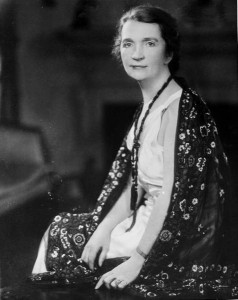 In Margaret Sanger in Context, Tracey McCormick defends the vilified Margaret Sanger. Sanger, who founded Planned Parenthood and advocated for planned parenting & birth control before women even had the right to vote, is often misquoted or quoted out of context.
In Margaret Sanger in Context, Tracey McCormick defends the vilified Margaret Sanger. Sanger, who founded Planned Parenthood and advocated for planned parenting & birth control before women even had the right to vote, is often misquoted or quoted out of context.
McCormick takes up defense of Sanger against New Jersey Congressman Christopher Smith’s quoting of Sanger from Sanger’s book, Woman and the New Race (1920): “The most merciful things a family does for one of its infant members is to kill it.”
This is McCormick’s response:
The line in question comes from Chapter 5, “The Wickedness of Creating Large Families.” Upon closer inspection, we see that Congressman Smith has left out the word “large” before family.
…But what if we read the entire paragraph or even the whole chapter?
…Apparently she hated miner families. Excessive childbirth in these families caused ill health in mothers, financial hardship to fathers, and I’ll quote directly for its effect on the children: “In the United States, some 300,000 children under one year of age die each twelve months. Approximately ninety per cent of these deaths are directly or indirectly due to malnutrition, to other diseased conditions resulting from poverty, or to excessive childbearing by the mother.
To demonstrate her hate, Sanger provides us mortality statistics of miner children, quotes a study by Arthur Geissler, which was later cited by Dr. Alfred Ploetz before the First International Eugenic Congress. (Eugenics is a scary word; if we took it out of context we’d realize that that’s what Hitler was up to. And if we practiced some really sloppy thinking, we’d say Sanger = Hitler. But we’re much smarter than that.)
To return to the statistics of children surviving through their first year. The first five children of these large miner families had about a 75% survival rate. The sixth-, seventh- and eighth-born approach a 70% survival rate. The eighth and ninth, about a 65% chance. The tenth, 60%; the eleventh, 50%; and the twelfth, 40%.
Five sentences later, Sanger drops her bomb: “The most merciful thing that the large family does to one of its infant members is to kill it.”
I didn’t know the woman personally, but I don’t think Sanger was a proponent of infanticide: I think she was trying to say and do something about the infant mortality rate. But you shouldn’t believe me. This is, after all, nothing more than a 750-word soundbite.
For context, you can read the entire chapter here.
For more-more context, the entire book, Woman and the New Race, is available here.
If you have four hours to spare, you can watch the entire hearing, “New Beginnings: Foreign Policy Priorities in the Obama Administration,” here. (Thanks, C-Span!)
Then, you’ll have context of Sanger and her relationship to “New Beginnings.
I applaud McCormick for taking up the fight here — both in terms of Sanger specifically and the issue of context in general. But one thing is missing from this conversation: The subject of eugenics itself.
The word “eugenics” has become an ugly thing, and rightfully so; but it too has its own context which must be understood. Understanding the context & origins of eugenics is key not only to understanding Sanger (and others), but its lessons are the epitome of the cornerstone of studying history: So that we do not repeat it.
Eugenics should not be simply or only equated with racism or even a scientific excuse for racism; that fine institution, racism, had already been in long practice. Eugenics has been around since the dawn of man; ancient societies, of all races, practiced infanticide for such purposes and Plato advocated that human reproduction should be monitored and controlled by the state. At the root of eugenics is a drive to improve human genetic qualities, better sustain the species, which includes everything from prenatal care for mothers to euthanasia.
But, yeah; racism sure was a part of eugenics for many.
American eugenics, as we speak of it here (referring to movements and social policies), was born in a post Civil War world where rapid growth of industrialization (including the increased mechanization of agriculture) created the first major migration away from farms, including former slaves. At the dawn of the Industrial Revolution there were a plethora of problems from such rapid urban growth. Cities were unable to keep up with the increasing populations; the exploitation of labor created militant labor organizations; swings in prices bankrupted many businesses — all of this led, in 1873, to a series of depressions which occurred roughly every decade through the early 1900s.
The depressions further fueled labor & over population issues, which were then additionally burdened by huge waves of immigrants (especially from southern and eastern Europe), which peaked just before World War I (and again after the war too). Then, as today, many Americans began to resent immigrants “stealing” their jobs, their housing, and even their spots in charity programs.
At first, “the poor” and the social & economic problems were, philosophically and physically (via social work, charity organizations, churches, etc.), addressed by Social Darwinism, the application (if not perversion) of Charles Darwin’s biological theory. While Darwin himself did not extend his theories to either social or economic levels, many educated people believed that “survival of the fittest” applied to (and therefore could be used to explain as well as manipulate) social and economic inequalities. But the irony was that the wealthy & powerful, “the fittest,” were endangered. Not only were the working class and the poverty stricken organizing themselves against the wealthy, but a declining birthrate among the captains of industry meant that the lower classes were out-reproducing them too.
Enter progressivism.
Progressive reformers believe(d) in the increased role of government to manage & plan for economic and social issues. Beneath working for the passage of legislation advancing the rights of the newly freed slaves; the establishment of labor unions, child-labor protections, & minimum wage laws; conservation of natural resources; direct elections in primaries, fairer taxation, & control of lobbyists; legislation to control monopolies, banking reform, & trust-busting; and working for women’s suffrage, lay science. (And a managerial class of educated experts capable of long-range planning.)
It didn’t take much for progressive reformers to convert inventive Americans to a strong faith in science as the way to address the problems plaguing the country. This opened the door, using the new science of genetics to spawn an even newer science of social engineering — eugenics. If genetics held the key to such things as alcoholism, criminality, “feeble-mindedness,” and poverty, eugenicists argued, society, who paid a high price caring for such individuals and their issues, should invest in the knowledge & planning to ensure a better genetic America.
Some went as far as to say that sterilization of one “defective” adult could save society thousands of dollars over future generations. So when researchers became interested in the heritability of such illnesses as schizophrenia, bipolar disorder, and depression, the findings of their studies were used by the eugenics movement as proof of its legitimacy, prompting state laws prohibiting marriages for and forced sterilization of the mentally ill in order to prevent the “passing on” of mental illness to the next generation. (These laws were upheld by the U.S. Supreme Court as recently as 1927 and were not abolished until the mid-20th century.)
Now remember the afore mentioned context; not only were social & economic issues a matter of The Haves & The Have Nots, but great tension arose from the fears of going from the former to the latter. The power of labor unions & the rise of the American socialist party combined with world events such as the successful Bolshevik Revolution, increased these fears, inspiring the wealthy to support eugenics. As today, funding for research & media meant that the wealthy could steer, if not actually dictate, the work of eugenicists. The repugnance for class struggles and political radicalism certainly figured into eugenics, resulting in selective immigration restriction.
In short, eugenics put such a focus on defective genes, individuals, and ethnic groups that it removed the focus from all the problems of the structure of American society itself. And the copious amounts of “scientific evidence” for eugenics being the rational and efficient plan for a harmonious future allowed the wealthiest in society to feel justified in blaming & controlling the victims.
I won’t go so far as to say that Margret Sanger was only philosophically identified with eugenics from the point of view of individual families using birth control to combat their economic & societal problems; there’s too much evidence that Sanger was into eugenics far deeper (& dirtier) than that. (While her work with The Negro Project & her acceptance of invitations to speak to women in the KKK remain controversial, there’s no arguing that Sanger was an eugenicist, including a proponent of using immigration laws to keep out those with “objectionable traits”.) I’m not even saying we should forgive & forget Sanger’s association eugenics because it gave us birth control. I’m saying we have to look at the context of the times — societal issues & individual concerns, education & prevailing science, fears & beliefs. And it’s clear that for a century, from the mid-1800’s through the mid-1900’s, eugenics was a huge part of the culture. So I think we should if not forgive, then at least not entirely condemn; but we certainly should not forget — not to be kind, but to see… To not dismiss. As Garland E. Allen wrote:
The problem with demonizing the older American eugenicists (many of whom thought they were taking the most modern, scientific and progressive approach to social problems) is that we distance ourselves from them and so can easily fall prey to our own biases today.
Margaret Sanger was not perfect. But looking at her life & work in context we are able to admire what is valid and also learn to accept the warnings we must heed about what is not valid.
Why We Vilify Single Moms
When I was in college I was a single parent. Finding myself struggling personally with the demands of continuing education and single parenting (a special needs child too yet) was challenging enough; but this was at the time that Tommy Thompson was governor & he made bashing single moms & welfare a public sport. (Yeah, some of us fought back; like the Welfare Warriors.)
It was incomprehensible how those of us left with children were not only held accountable while biological dads walked away Scott-free, but were to blame for all of society’s ills. Even those who raised children alone by design & without public assistance were vilified, a la Murphy Brown. It wasn’t just moral outrage (though that did & does exist); it wasn’t an ignorance — these were educated people saddling us with unrealistic responsibilities and ludicrous outcomes. We were being scapegoated with such an intensity that it must be hiding a deep fear of some sort… Was it simply another way to display the classic fear & hatred of “female,” or was there more?
It got me thinking: Certainly being a single parent had never been easy, but had it ever been easier? At least from a societal point of view?
A classmate & friend, another single mother herself (shout-out to Vicki Davidson, if she can hear me!), decided to investigate. What we found would later be presented at one of those extra-curricular brown-nosing events (in the history department, which didn’t help with any of our majors; but we did, I will say, impress the department staff with work that, I quote, “was at or above masters work”).
What we discovered, was that the vilification of women having (&/or raising) babies out of wedlock dated back to Victorian times. This may not surprise many who would attach such times to the origins of our currently held morality — but it wasn’t (at least entirely) Queen Victoria’s morality that had done the deed & made single mothers dirty; it was mainly a byproduct of the Industrial Revolution.
Before the Industrial Revolution, children had great value in farming; any additional mouths you have to feed come with additional, literal, farm hands. Mom, dad, older siblings still did their work as they watched the littler ones; little ones automatically observed the work and therefore received on-the-job training under the auspices of childcare. Large families meant there was no need to hire help — and mom & dad were assured someone would be there to care for them as they aged.
This, more than church-hurled slurs about paganism, is the more practical reason why when Mr. or Mrs. Farmer wandered down to the next farm for a roll in the hay, no one worried about an illegitimate child. Why fuss about Mrs. Farmer being knocked up by a neighboring farmer when it’s just more farm hands? Especially when you spotted proof of your own afternoon delight working at a neighbor’s farm. (It was not uncommon for casual acknowledgment of such situations; no rows ensued, unless someone wanted those little hands for their own farms. And it begs for some research regarding jokes about the farmer’s daughters.)
But the rapid growth of industry, including the increased mechanization of agriculture, created the first major migration away from farms to cities and changed everything.
Among the many problems with such rapid urbanization comes the devaluation of children. Children are not only less desirable industrial workers (especially after childhood labor reform acts), but they also become an economic drain; more mouths to feed, but no automatic work hands.
From 1861 through 1885, several Acts were instituted which significantly affected the working-class mother. The first of these Acts was the 1861 Offences Against the Person Act. According to Carol Smart, in her essay “Disruptive Bodies and Unruly Sex: The Regulation of Reproduction and Sexuality in the Nineteenth Century,” this was established to deal with “rape, procuring, carnal knowledge, abortion, concealment of birth and exposing children to danger” (13). Throughout the nineteenth century, incidents of infanticide were continually on the rise, in large part because little was done to convict the guilty party. Violent acts by desperate working-class women resulted in a movement to put more emphasis on holding someone, namely the mother, responsible for these deaths came to a head with the passing of the 1861 Offences Against the Person Act. As working-class women oftentimes found themselves financially challenged, they would accordingly find themselves financially unable to support their children (Smart 17). Women who gave birth to illegitimate children found themselves in a particularly questionable situation. On the one hand, if a woman kept the baby, she would likely be unable to properly provide for it; however, if she concealed her pregnancy and abandoned the child, she would be held liable, with the potential of being sentenced to hang, regardless of whether the baby was born alive or dead (Smart 16). Women who had children out of wedlock, who were unable to financially support their children had to face the difficult decision whether to keep the child or turn the infant over to another’s care, thus avoiding the repercussions of being found guilty of infanticide.
But what of the children?
Those visions you may have of beautiful Victorian cherub-children, the history which boasts of Victorian times “finally” bringing about children’s toys & a time “when children could finally be children,” these are not representative of most children. The average child in Victorian times was trapped the poverty, grime & disease of the Industrial Revolution — just as their parents were. The juxtaposition of the images isn’t graphic fantasy; there were two worlds. (Just as there were two worlds in terms of Victorian morals & sexuality; but that is for another time.)
The wealthy children may have found themselves clean, well dressed & with plenty of playtime on their hands, but most rural children spend their time hungry & packed in one room with 3-9 siblings & their parents or working as hard as their parents to ensure the family’s survival. And those were the lucky ones. Some went to prison — yes, children went to prison for their crimes, and some were even hung for them.
Disease & injury at work, along with other conditions of urban poverty, did leave some children orphaned; and with no family nearby, or none willing & able to take them in, there became the street urchins of Oliver Twist tales. However, orphans were not the only urchins running the streets.
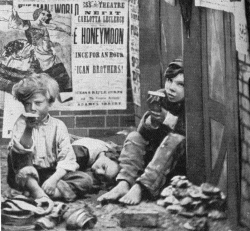 Along with orphans, there were abandoned children & children of the homeless living on the streets. The streets were littered with trash & children (including some children who were there just trying to help their families eek out a living). These children were often called “street Arabs,” an ethnic slur for nomadic activities that weren’t understood.
Along with orphans, there were abandoned children & children of the homeless living on the streets. The streets were littered with trash & children (including some children who were there just trying to help their families eek out a living). These children were often called “street Arabs,” an ethnic slur for nomadic activities that weren’t understood.
To care for the orphaned & stray children, the Victorians built many large orphanages (along with lunatic asylums and infirmaries to house, if not care for, those unable to work, and workhouses).
Once built, orphanages housed more then orphaned & abandoned children. Poor mothers and fathers negotiated with institutions to place their children there temporarily, for assistance to overcome short-term family and economic crises. These children were called the “ins and outs” or “casual children” because of there frequent short stays at institutions.
As you can imagine, what with all the popular “fallen woman” & prostitution stories from this time, a large number of casual children came from single parent households. Not all single parents were unwed or even single mothers. Some single parent situations were created by deaths, of course, but it was also not that uncommon for one parent to be institutionalized, put in a dreaded workhouse, or in prison; leaving the other parent to fend for themselves and the children alone. But single mothers were among the majority of those who used the orphanages as temporary shelter for their children or abandoned them there entirely. Some even used the institutions as a sort of childcare; placing their children there while they went to work as live-in maids etc., visiting the children on days off.
Whether these buildings were public works or run by private charities, at some point people began to stand up and ask themselves, “Why am I paying to support someone else’s child?”
Great pains were taken to interrogate mothers & the children themselves to ascertain the name of the father, so that he could be held accountable. This meant financially responsible — but not in payments or support of any kind to the child or the mother herself; no, responsibility was only a matter of repaying the state or institution, or claiming the child so that the father’s household supported the child. In cases of wealthy fathers, women were sometimes paid not to name them, lest wives or potential wives would use the current morality to dismiss the marriage or diminish (shame) them socially. (This is the start of many of those fantasies of a wealthy parent who will come for a child & rescue them.)
More then simple resentment at having to part with money though, the was another moral issue: Poverty.
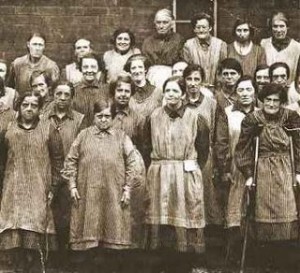 Poverty was seen as a character defect; not a circumstance. The poor were poor because they were vagrants, drunkards, morally bankrupt prostitutes, etc., and when it came to their children it wasn’t only that no one wanted to fork over their money to feed a little hungry mouth they did not create, it was a mistrust of the irresponsibility involved.
Poverty was seen as a character defect; not a circumstance. The poor were poor because they were vagrants, drunkards, morally bankrupt prostitutes, etc., and when it came to their children it wasn’t only that no one wanted to fork over their money to feed a little hungry mouth they did not create, it was a mistrust of the irresponsibility involved.
Because it’s always been easier to vilify victims than to address the problematic social structure.
The most offensive & objectionable children the charitable organizations & social institutions served were the casual children who went back & forth between decent orphanages and “no good” poor parents. These children were commonly referred to as sources of “evil,” suggestive of their status as disease carriers & corruptors of morality (including alleged sexual knowledge), infecting the innocent & redeemable orphaned & abandoned children. It was the attitudes about these casual children which actually infected the general society with a sense of distrust about orphanages.
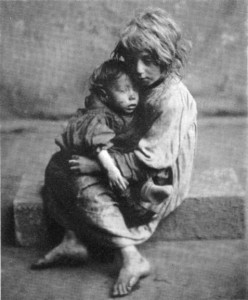 To combat societal distrust, reformers & social workers began PR campaigns to paint all the children in orphanages as orphans and strays. This may have begun simply to improve the images of orphanages & garner funds, to distance the children themselves from the sins of their pauper parents, but in many cases the positive spin shifted to advocating legislation.
To combat societal distrust, reformers & social workers began PR campaigns to paint all the children in orphanages as orphans and strays. This may have begun simply to improve the images of orphanages & garner funds, to distance the children themselves from the sins of their pauper parents, but in many cases the positive spin shifted to advocating legislation.
Attempts were made by so-called social reformers to do away with casual children by removing their parents from the picture, making them into situational orphans, often using legal maneuvers & legislation to prevent pauper parents from having rights to their children. Such removal of parental rights was, understandably, feared even more than being sent to the workhouses and argued against. But the legislation was pushed hard by many. One of the reformers, Florence Hill, put it this way, “Parents who have cast the burden of their children on the State should not be free to interrupt their being made good citizens, for evil purposes of their own.”
But in their quest to increase charity and government aid to children, such reformers cast the poor not only in a poor light but cast them even further away from the Victorian social body. The poor became even more disenfranchised, more vilified.
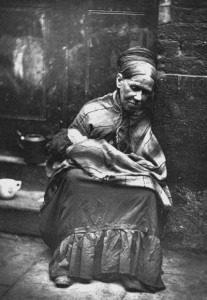 And this, my friends, is why single mothers continue to be scapegoated today. The poor continue to be judged as possessing character defects, children remain an economic drain — or “investment” if you prefer (so much money in before you might expect any return), and society doesn’t want to help with either the investment in those children or take a serious look at the very structure of society which in all actuality creates the poverty in the first place.
And this, my friends, is why single mothers continue to be scapegoated today. The poor continue to be judged as possessing character defects, children remain an economic drain — or “investment” if you prefer (so much money in before you might expect any return), and society doesn’t want to help with either the investment in those children or take a serious look at the very structure of society which in all actuality creates the poverty in the first place.
This is made worse for single mothers who continue (despite scientific knowledge to the contrary) to be blamed for bringing their children into this world. Ironically, the very women we blame for (further) impoverishing themselves by having children have the least access to family planning, are the most restricted regarding exercising their rights to their own bodies, and continue to be courted by religious & “moral majority” groups who judge, condemn, & ostracize them.
History repeats, continues, if we do not learn from it.
Popular Racism, 1857
In 1857 (a year before Darwin’s The Origin of Species), creationists Dr. Josiah C. Nott and George Gliddon published Indigenous Races of the Earth, which included illustrations comparing the skulls of “Greeks,” “Negroes,” and Chimpanzees to suggest black people ranked between white people and chimps. All copies of Indigenous Races of the Earth were pre-sold before they were even printed and the book then went on to become one of the best selling books of the time, including being published in many languages.
I Collect Bitch Like It’s A Good Thing
 Taking a look at retro & vintage images of female domesticity (or the sales of such) is a fascinating part of my collecting.
Taking a look at retro & vintage images of female domesticity (or the sales of such) is a fascinating part of my collecting.
For every bit of useful information (research help, household tips & recipes), there is the moment of shocking disgust that even though you already knew of its existence (or at least expected to find something like that there) results in the auditory combination of frontal forehead slap and an “arg!”
This sport has become quite popular, even among the non-collecting set, who have exploited the kitsch of yesteryear & reclaimed it in the names of feminism and/or capitalism, spawning a bajillion blogs and inspiring Anne Taintor, among others.
And we buy it by the barrel. From “Guess Where I’m Tattooed” emery boards to sticky notes; from blank journals & greeting cards to ID cases & compacts.
Derogatory statements & words (like the B-word, bitch) were often reclaimed by women, much like the N-word; only we women could use those words, label one another & our products with them.
Obviously, sometimes, it was pure capitalism. Perhaps even with a pinch of misogyny — or at least irony — as it was men like Ed Polish & Darren Wotz who really capitalized on women’s mockery of their own history by selling them bold & defiant sayings juxtaposed with domesticated retro images of women.
At some point whatever genuine interest there may have been in giving females a hearty last laugh at female history was perverted into a glut of raunchy retro styled products which twisted & sometimes down-right confused sexism with sexy. At first, it felt only natural to mock & rebel against the ridiculous notion of woman as virgin & then (married) mother — with never a thought to her own pleasure or desires.
So, much like the B-word, we took over the S-word, co-opting it for our own use, putting “slut” on a slew of merchandise.
Bur then we went too far, I think, including putting “slut” on clothing for kids. *gasp* (No, I won’t link to or promote any of that.)
 Most of the retro rebelling merchandise has it’s only value in the humor, being poor product inside slick packaging, and they often don’t stick around long.
Most of the retro rebelling merchandise has it’s only value in the humor, being poor product inside slick packaging, and they often don’t stick around long.
Products such as Bitch & Slut Body Detergents are no longer are around (hello, collectible!) — but in the specific case of the body detergents, the problem was with the icky gritty soap, not the packaging. (And it should be noted, in the interests of accuracy and equality, that Mabel’s LaundrOmat also served silly, dirty & derogatory soaps about men too.) However, it seems the company continues to make stereotypical sundries which may chafe & chap those without the ability to laugh at things such as Extra High Maintenance & Extra Dizzy Blond Lip Balm.
Today, it’s difficult to enter a hip gift shop, bookstore, or boutique and not be bombarded with such humorous merch. A lot of it is funny. But some of it seems to actually be reinforcing the old myths & stereotypes. And many of the profits in the process of using humor to free women from the humiliating shackles of the past are lining the pockets of men, not women… Is that really liberating? Or funny?
I wonder about that stuff when I buy it for my collection. Because even while I may be “documenting history” (and modern items are both “today” and “history”), I don’t want to be buying the old party line when I buy my trinkets, you know?
Anyway, when you look at it all on the shelves, at a store or in a collector’s home, all this reclamation of womanhood says something… I’m just not sure what yet.

Of Farrah Fawcett & The Trouble With Feminism
I was kitsch-slapped myself, reading this line (in one my feeds) from Linda Lowen’s post regarding Farrah Fawcett’s death:
Considering the fact that Fawcett was one of those impossible-to-live-up-to female images that feminists rail against, there’s been surprisingly little commentary about her passing or about her role in pop culture history from feminist circles.
Ugh, where do I even begin?
 I could try to rectify the “little commentary from feminists” comment by showing all the other posts I’d read (and skimmed in feeds) in which feminists eulogize Farrah; but I’m a bit too lazy — and hot under the collar — to gather them all.
I could try to rectify the “little commentary from feminists” comment by showing all the other posts I’d read (and skimmed in feeds) in which feminists eulogize Farrah; but I’m a bit too lazy — and hot under the collar — to gather them all.
Then there’s the matter of this, Lowen’s response to Lisa Westerfield’s “feminist Farrah Fawcett” piece (originally published prior to Fawcett’s death; republished the day the actress died):
Still Expected to Cook Dinner
Westerfield doesn’t make this point, but Fawcett’s marriage to actor Lee Majors (who played the Six Million Dollar Man) was more of the same old ‘Cinderella marries the Prince’ story than a fresh, modern tale of a strong woman controlling her own destiny. (Westerfield, however, does acknowledge that Fawcett had to leave the show in time to go home to make dinner for her husband each night.)Sorry, but this is not the stuff that feminist icons are made off.
So marriage makes one less of a feminist? Or is it just specific kinds of marriages, left undefined, that Lowen doesn’t like? I can’t tell. And then she mentions the whole “making dinner for her husband thing.” So boring. But more upsetting actually that here I go again…
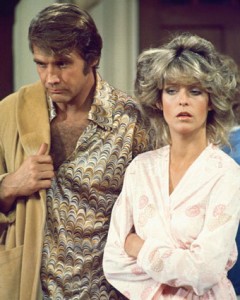 The truth is, we cannot know exactly why Farrah wanted out of Charlie’s Angel’s… Whether if was for “bigger bolder career reasons” or if she “had” to be there to make Lee’s daily dinners, or maybe, and this is too often left out of the conversation, Farrah herself wanted to be there make, serve & enjoy those meals with Majors more than be on TV. If she wanted to be there to make his man-meals after work or instead of her own career, that was her damn choice.
The truth is, we cannot know exactly why Farrah wanted out of Charlie’s Angel’s… Whether if was for “bigger bolder career reasons” or if she “had” to be there to make Lee’s daily dinners, or maybe, and this is too often left out of the conversation, Farrah herself wanted to be there make, serve & enjoy those meals with Majors more than be on TV. If she wanted to be there to make his man-meals after work or instead of her own career, that was her damn choice.
That’s what feminism is about; a woman’s right to choose the life she leads.
And yes, that includes the right to play 1950’s atomic “mommy” to her man. It may be, for some folks, harder to swallow than that retro lime Jell-O with its suspended carrot shavings; but suck it up & choke it down, because that’s still an option a woman has the right to choose. You have no more right to tell her she can’t than anyone else can tell her she must.
If she made that choice to be “Mrs.” rather than focus on a “career,” that is the stuff feminist icons are made of.
If she didn’t really, or freely, make that choice, as many claim, let’s look at why that would be… She went, as most women then did (and many still do — or are expected to), from Daddy’s Little Girl to The Little Woman. Breaking out of such family dynamics isn’t as easy as marching on Washington, you know. It is an individual act, done in isolation, railing against a patriarch you love; while the latter is undertaken en mass, railing against a The Patriarchy. Standing up to a man you love (whose face you adore), as opposed to standing up to The Man (who is anonymous & faceless), requires a maturity most women, especially without personally accessible role models, do not achieve until they are in their 30’s or beyond.
This Farrah did.
Isn’t that the stuff feminist icons are made of too? Or must we only be recognized if we are born with the power of rebellion, railing against things we don’t yet understand?
But what sticks in my craw most, are all the assumptions packed into one neat line in Lowen’s article: “the fact that Fawcett was one of those impossible-to-live-up-to female images that feminists rail against.”
Fact?! Who the hell says that all feminists rail against beauty? Most of us may rail against the need &/or pressure to conform to (white male) versions of “beauty,” but many of us are wise enough to realize that when a female is beautiful, impossible to live up to or not, she’s, well, she’s just beautiful.
Beauty, by itself, means nothing more, nothing less; no objectification necessary.
Nor is there a need for hatred or jealousy, or whatever pretense the stereotypical snark is supposedly serving. Such things are patriarchal constructions to divide & conquer women; crap I, and others, simply won’t perpetuate.
Some of us are also wise enough to see how beauty can & will be used against the one who possesses it. Not just in Hollywood, which rakes in money exploiting fair face & figure, while unfairly limiting actresses (such as Marilyn Monroe, Farrah Fawcett, Lucille Ball, and, recently, even Tina Fey) to (stereo)type; but everywhere.
Farrah fought against such things, not just with her stage & screen roles which eventually earned her some respect, but in her own life. Why diminish her to mean-spirited comments disguised as wit, like this comment left at Correctly Impolitic:
Here’s why the hoopla about MJ and not FF:
Michael Jackson was a spectacular talent who had mediocre hair.
Farrah Fawcett was a mediocre talent who had spectacular hair.
To mock a woman & diminish her value to only that of an icon of beauty, or “spectacular hair,” is abusive. Like an abusive spouse, such devaluation at the hands of an individual or a group culturally is an attempt to isolate and control.
To mock a woman & diminish her value to only that of an icon of beauty, or “spectacular hair,” is objectification. You are objectifying her.
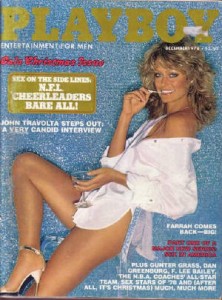 And don’t give me this BS that she’s asking for it; no one, Playboy fantasy girl or not, wants to be viewed solely for their occupation or one facet of their life.
And don’t give me this BS that she’s asking for it; no one, Playboy fantasy girl or not, wants to be viewed solely for their occupation or one facet of their life.
Fawcett fought to have others see her many facets. She fought to make some decidedly feminist productions. But even if she had opted to make a career out of jiggle TV & silly bimbo roles (stuff our culture digs with a big spoon, allowing “dumb bimbos” to laugh all the way to the bank), she’d still be a feminist in my book. As long as she had choices to make & was exercising her right to choice, she was a feminist.
A beautiful feminist.
Why is that so difficult to accept?
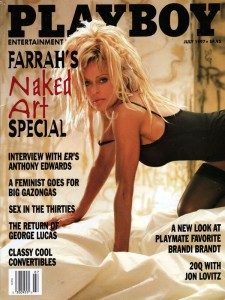 You know, it’s so damn weird that people actually spend time discussing whether or not so-and-so’s hair coloring is real — and if she colored/bleached it, if she’s doing it for the patriarchy. Why waste your time on that? Isn’t it enough that there’s an asshat ready to call you old, fat & ugly the minute you stand up for yourself or dare to assert your rights as a female? While their words are no sticks & stones that can break our bones, they are designed to hurt us, discredit us, and I resent the attempts. Are my words less important if I am ugly? No. Making oneself ugly to be taken more seriously or make one “more feminist” doesn’t work either. So beauty, even great amounts of it, do not remove one’s ability to be smart or dilute one’s ability to be a feminist.
You know, it’s so damn weird that people actually spend time discussing whether or not so-and-so’s hair coloring is real — and if she colored/bleached it, if she’s doing it for the patriarchy. Why waste your time on that? Isn’t it enough that there’s an asshat ready to call you old, fat & ugly the minute you stand up for yourself or dare to assert your rights as a female? While their words are no sticks & stones that can break our bones, they are designed to hurt us, discredit us, and I resent the attempts. Are my words less important if I am ugly? No. Making oneself ugly to be taken more seriously or make one “more feminist” doesn’t work either. So beauty, even great amounts of it, do not remove one’s ability to be smart or dilute one’s ability to be a feminist.
It’s such a damn mess being a judged woman. You can be a bitched at beauty, or simply dismissed as a bimbo, one minute and then called a fat cow the next just for asserting yourself or educating another with some fact or other (maybe even for daring to mock Sanjaya). It happens at Wal*Mart, in academia, in the blogosphere, at family reunion picnics… Everywhere & anywhere. And I’m sick of it.
Stop this incessant bitching about who is and isn’t being a good feminist or feminist role model. Stop worry about who wears lip gloss, bleaches her hair, & why. Stop making snide gossipy comments about who is a stay at home mom, a working mom, or a true career woman; who does or doesn’t have kids; who does or doesn’t have a man — who doesn’t even want a man — and why. Just stop worrying about what people choose to do (99 times out of 100, it has nothing to do with anyone’s safety or your life) and start worrying about whether people have equal rights to control their own lives.
That’s what feminism & true equality are all about.
 And if you’ve got spectacular hair, a killer smile, and only-too-happy-to-be-seen perky nipples, good for you. You’re beautiful! Why on earth should I make that your cross to bear or discuss if that makes you “feminist enough?” I’m only worried if you’ve got the right to make your own choices in life.
And if you’ve got spectacular hair, a killer smile, and only-too-happy-to-be-seen perky nipples, good for you. You’re beautiful! Why on earth should I make that your cross to bear or discuss if that makes you “feminist enough?” I’m only worried if you’ve got the right to make your own choices in life.
And to hell with the rest of ’em who want to put you in a box.
Especially when the only box you really are in is your coffin.
Farrah exercised her ability to choose how to live her life as best she could; and that’s as feminist as it gets.
Does Mattel Sock It To Us With Goldie Hawn Barbie?
Speaking of flags painted on Goldie Hawn’s body on Laugh-In…
To celebrate Barbie’s 50th anniversary, Mattel’s 2009 Barbie Doll releases feature a number of iconic retro doll re-do’s & celebrity dolls — including a very accurate version of Goldie Hawn as seen on Rowan & Martin’s Laugh-In. Look at the incredibly detailed reproduction of Goldie’s bikini & body painted tattoos, as seen in 1968:
Part of the Blonde Ambition Collection (officially said to be available July 1st, the Goldie Hawn Barbie is available now at eBay, Amazon
, and a few select doll retailers), Goldie joins Marilyn Monroe as a vinyl delight for collectors.
And this doesn’t offend me in the slightest.
In fact, I want one.
While Babs has often been cursed as the vinyl bringer of doom, providing body image issues to little girls everywhere, I don’t have a problem with a pop culture history reproduction. And it’s not because I’m a collector &/or that Barbie’s boobs have been reduced for the Goldie version.
First of all, the Goldie Hawn Blonde Ambition Barbie is for adults; not kids.
Kids should not be given a doll they do not understand (and that includes the societal context of the times she comes from). Kids also shouldn’t reduce a $40-50 doll to garbage; and let’s face it, Goldie’s tats, understood or not, would be abraded away with childhood play.
We adults already know of Goldie & the cultural context of the time. Our body image issues, however affected & formed, are also our own responsibilities; we are old enough to say to ourselves and the world, “I’m a woman, I look like this, and I’m happy with it.” Or not, as the individual case may be. (And then we should seek help for our own issues, no matter how they were formed; finger pointing alone won’t help us love our bodies or keep them healthy.)
Second of all, as a feminist, I have a long and deep relationship with Barbie.
I played with Barbie as a young girl. And, while my sister thinks it’s so hysterical that she tries to embarrass me with this fact, I have no problems admitting it: I played with Barbies until I was 16. I loved to take pretty vintage handkerchiefs & other bits of fabric and pin them on my dolls, then pose them in little vignettes with the Barbie accessories, in the garden, etc. I was exploring visually, creatively with the tools I had at the time. I couldn’t sew; so I pinned on the fabric. I didn’t have a real camera (and the means to pay for all that film & developing); so I created scenes & literally used my hands to frame the images I’d capture in my mind’s eye — reconstructing, reposing, redressing, until I saw what I wanted.
I could be odd — and this may not be the “most normal” Barbie play; but then, when I see other kids playing with fashion dolls, I see quite a bit of that too… I don’t think my “oddness” stems from how I played — or how long I played — with fashion dolls.
Of course, as I got older I became suspicious of Bab’s and her figure. This was further complicated by media images, feminist discussion, and the fact that I looked far more like Barbie than most of my friends & family did…
I noticed that in books, films, television shows, etc., that the voluptuous women were most often the “evil” ones. We big-busted women were depicted as “man traps” and were not to be liked or trusted by other women either. Our assets were too compelling. We were competition. Our looks garnered looks — and the whole thing was diabolically unnatural (even when it was all so completely natural). It was bad, we were sinful; therefore we were The Enemy.
It was saddening, maddening.
But it wasn’t Barbie’s fault. It wasn’t even Mattel’s fault.
As a society we were sold on beauty & sex appeal, no matter how realistic or not the standards are; but if you dare to have it (and this was something deemed & defined by others, it was not even necessary for it to be exhibited or used by yourself), you were viewed suspiciously… Punished, ostracized.
But it wasn’t something a plastic doll did. And the only reason Mattel and others could sell it was because our culture greedily consumed it. And then made weird judgments about it. WTF.
While some blame Barbie for unrealistic body image, others condemn the doll, her world and her friends for an insipid, unrealistic, & exaggerated sense of romance; I find she exposes even more about our twisted cultural values & expectations. Barbie is a useful tool.
This relationship with Barbie is one I’m still trying to figure out… And the commercial processing of more dolls, how the marketplace reacts to them, and the resulting opines of others could all just get me closer to some better understanding.
Besides, if I don’t like Barbie, I don’t have to buy her — for myself or anyone else. What’s more, I can let her coexist in this world without buying her ideals either.
Some Lessons In The Soiling Of Old Glory
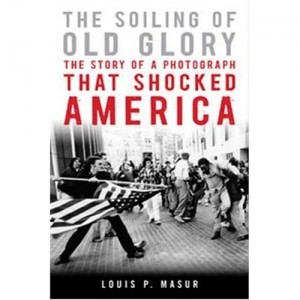 At Collectors’ Quest I just reviewed Louis P. Masur’s The Soiling of Old Glory: The Story of a Photograph That Shocked America — a book I can’t recommend highly enough.
At Collectors’ Quest I just reviewed Louis P. Masur’s The Soiling of Old Glory: The Story of a Photograph That Shocked America — a book I can’t recommend highly enough.
While the book is based on a very famous photograph, the Pulitzer Prize–winning photograph by Stanley Forman, taken on April 5, 1976 at a Boston rally against forced school busing, I’d never heard of or seen the photo before.
I don’t know why.
I was 12 years old at that time and I remember vividly Watergate, Viet Nam, etc.; so I obviously absorbed news. And I’ve always been interested in, sensitive to, and emotional regarding matters of race — something I’ve since put down not only to a combination of being human, being female (and so recognizing oppression), and “white guilt,” but as spiritual residue from being born on June 21, 1964, the date of James Chaney, Andrew Goodman, and Michael Schwerner were murdered (something I never knew until I was about 25 and rented Mississippi Burning). Plus, I’ve been a very avid student of history. So just how the incident & photograph escaped my knowledge is a mystery to me…
But once I found Masur’s book, my ignorance left.
And not just my ignorance regarding this (and other) incidents of relatively recent racism in this country (and in “the liberal north” yet!), but about photography, art, symbolism… And this country’s flag.
I had no idea that someone from my home-state of Wisconsin was so influential in the creation of National Flag Day, or that the Milwaukee Daughters of the American Revolution played a role in early anti flag desecration legislation. In fact, I had no idea that there was such concern over flag desecration as early as the late 1800’s. But what really rocked my cynical world was the reasoning behind it. Masur wrote (pages 98-99):
Even as the flag came to be venerated in the late nineteenth and early twentieth centuries, it became subject to another kind of treatment: desecration. Of course, it makes perfect sense that the two might emerge side by side, an object worshipped and reviled, an icon and a target. Reports and pamphlets in support of legislation against federal flag desecration began to appear, primarily in response not to overt acts of destruction but to the commercial use of the image of the flag. Arguing that “old glory is too sacred a symbol to be misused by any party, creed, or faction,” one writer included a list of objects on which “old glory… is treated with grave disrespect or used for mercenary purposes.” The items ranged from pocket handkerchiefs and doormats to lemon wrappers and whiskey bottles. In 1890, the House Judiciary Committee recommended passage of a law that made it a misdemeanor to “use the national flag, either by printing, painting, or affixing said flag, or otherwise attaching to the same any advertisement for public display, or private gain.”
What strikes me so odd — not that it should, I suppose — is that folks were so upset by the commercialization of the U.S. flag.
What on earth would they think of today’s patriotism? Of our current state of ridicule of anyone not wearing or displaying, on person or product, an American flag?
That sound you hear is the thud of fainting conservatives from the late nineteenth and early twentieth centuries. Or maybe it is the screams of horror from the same.
Once I wrapped my mind around such societal flip-flop, I then was left to revisit my own memories of the flag. A flag I’d seen on so many things… And that was before 9/11.
Heck, walk down any major isle at oh-holy-Wal*Mart this week, and try not to find something with the U.S. flag printed on it — tank tops with the flag & little white puppies, disposable plates with flags on them, socks with flags & fireworks, seat cushions… Endless. And all made to be profited from.
Was the Bicentennial responsible for this?
Back then (and I don’t mean just 1976, but the years surrounding it too) we had our school pictures taken with flag backgrounds, ate off flag forks, plastered cafeterias with flag-printed crepe paper & balloons, even applied flag printed toilet paper to clean our dirty butts. It was as bad as Masur notes, and, as he quotes, by then at least one member of the Sons of the American Revolution was OK with such kitsch: “I see no harm in these Bicentennial products. There is no harm in making a buck.”
But while the Bicentennial was the height of flag kitsch, I had some memories of flag use and “abuse” before then…
Again from Masur (page 107):
The meaning of America and the meaning of the flag went together. As the counterculture of the late 1950s and the 1960s came into prominence, attempts to redefine America often meant desacralizing the flag by wearing it. The cultural rebellion of the 1960s necessarily implicated the flag. [Allen] Ginsberg came to sport a top hat with the American flag motif. In discussing Ken Kesey, the Merry Pranksters, and the drug culture of the 1960s, Ginsberg argued that “they didn’t reject the American flag but instead washed it and took it back from the neoconservatives and right wingers and war hawks who were wrapping themselves in the flag, so Kesey painted the flag on his sneakers and had a little flag in his teeth filling.”
This was as I recalled from my television set. The protest film footage, the body paint on Goldie Hawn & Judy Carne on Laugh-In (and if the girls hadn’t actually worn flags painted on their bodies, well, I said it was as I recalled it…) It may not all have been as commercial as the Bicentennial kitsch was; but it was there, making it’s own statement, whether you dug it or not.
In the end, I agree with Supreme Court Justice Robert H. Jackson who, ruling on West Virginia State Board of Education v. Barnette in 1943, said:
To believe that patriotism will not flourish if patriotic ceremonies are voluntary and spontaneous instead of a compulsory routine is to make an unflattering estimate of the appeal of our institutions to free minds. We can have intellectual individualism and the rich cultural diversities that we owe to exceptional minds only at the price of occasional eccentricity and abnormal attitudes. When they are so harmless to others or to the state as those we deal with here, the price is not too great. But freedom to differ is not limited to things that do not matter much. That would be a mere shadow of freedom. The test of its substance is the right to differ as to things that touch the heart of the existing order.”
I don’t for a moment consider the use of the flag as a weapon to be anything other than criminal; that’s not my intent in any way. While the photo and exploration of the cult of flag connect in Masur’s book (they have to; the flag as symbol must be discussed), that’s not his point either. But what you have to see is a time, not long ago, when many felt the flag, like the country, didn’t represent them any more.
Here Masur repeats a quote Kenneth Clark published in Dark Ghetto:
The flag here in America is for the white man. The blue is for justice; the fifty white stars you see in the blue are for the fifty white states; and the white you see in it is the White House. It represents white folks. The red in it is the white man’s blood — he doesn’t even respect your blood, that’s why he will lynch you, hang you, barbecue you, and fry you.
There are many times I feel that way. Not just in theory. Not just as continuing amateur historian. But as a woman living her life here as a second class citizen. Without equal pay. Without the same recourse & credibility when she stands to seek justice. Without recognized rights to her own body. And with far greater (& societal accepted) risk of violence & sexual assault.
Why isn’t my gender’s blood part of the red on the flag?
I feel a reclamation-of-the-flag art project coming on.
Happy Fourth of July.
Twitter Of 1950
Quick, a vintage news weekly magazine, promoted itself on page 65 of the July 31, 1950 issue, with quotes from readers (along with a subscription form, should you so be moved), which illustrate that the “quick” news blurbs and short “frequent,” “accurate,” and “up-to-the-minute” information was “invaluable” to professionals, such as John L. Gary, Superintendent of Schools, La Center, Washington, and Margaret Webster, “distinguished Shakespearean director.”
Then people were thrilled to receive “digests” of “what is going on in the world,” to have “short-cuts” assisting them, helping them save time in a rapidly moving world — just as those of us who use Twitter do now. Well, at least that what Quick wanted you to think so you’d be moved to clip that subscription form and send it in.
I had just scanned the page from Quick magazine so that I could make the pithy comparison and add this 1950’s update to your history of Twitter (see also: Robot Messenger Displays Person-to-Person Notes In Public, Aug, 1935), when what do you suppose happened?
Just a few days later, presumably after finding & reading my article about the vintage publication, Clyde Hostetter, Professor Emeritus at California Polytechnic State University, emailed to ask if I have a copy of Quick published about 1948 “with a cover photo of sick women lying in a hospital corridor as the result of a mass food poisoning in Topeka, Kanas.” Seems Mr. Hostetter, then a writer/photographer for what was then the Topeka Daily Capital, is the one who took the photo of the woman suffering from food poisoning and, it being his first & only cover photo on a national magazine, he was eager to have a copy of it.
This is not the first time I’ve been delighted to make connections with people over my old magazines & ephemera; for example, I’ve helped provide images for the new walking tour of the Hingham Shipyard Historical Exhibit & helped family of legendary poodle trainer, instructor, & author Blanche Saunders find out more about “Great Aunt Blanch.” So it was with sincere regret that I wrote back to Hostetter to inform him that I did not own the copy he was looking for (even though I write about things found in Quick quite often, I currently only have three issues of that magazine). I told him if & when I discover a copy, I’d be sure to let him know.
Hostetter did have a great gem to share about the good old days of journalism — and it’s equally applicable to today’s discussion of Twitter & blogging:
I forgot to mention the joke that went around in the newsrooms when Quick first hit the newsstands with its acutely shallow summary of the week’s news. It was said that Fleur had another idea for a magazine called WORD. It would be published weekly like Quick. Every week the editorial staff would gather and chose a word for the total content of that week’s issue.
I find it very interesting (and, I’ll admit, somewhat amusing) to consider those days of print journalism, the old guard & the new guard competing against the assault of that new menace, television, discussing integrity & worthiness. Its comparisons to newspapers and magazines today and their view of the internet and digital media cannot be underestimated. And the super news is that Mr. Hostetter seems willing to continue sharing his memories of those days… So stay tunned to read more in the future.
Can’t Be A Sleeping Beauty On Real Issues
Via Teacups & Couture I found the works of photographer Dina Goldstein which follows up with fairy tale princess and their “happily ever afters.”
Goldstein shares her exploration of Disney Princesses in Fallen Princesses at JPG Magazine:
These works place Fairy Tale characters in modern day scenarios. In all of the images the Princess is placed in an environment that articulates her conflict. The ‘…happily ever after’ is replaced with a realistic outcome and addresses current issues.
The project was inspired by my observation of three-year-old girls, who were developing an interest in Disney’s Fairy tales. As a new mother I have been able to get a close up look at the phenomenon of young girls fascinated with Princesses and their desire to dress up like them. The Disney versions almost always have sad beginning, with an overbearing female villain, and the end is predictably a happy one. The Prince usually saves the day and makes the victimized young beauty into a Princess.
As a young girl, growing up abroad, I was not exposed to Fairy tales. These new discoveries lead to my fascination with the origins of Fairy tales. I explored the original brothers Grimm’s stories and found that they have very dark and sometimes gruesome aspects, many of which were changed by Disney. I began to imagine Disney’s perfect Princesses juxtaposed with real issues that were affecting women around me, such as illness, addiction and self-image issues.
There are 2 more to be shot for this series which is going on exhibit on Oct. 15/09
The images are striking; the subject matter near to my heart.
I did some work in college on the messages in Disney images & stories. My project, Damaged By Disney, was similarly inspired by watching my then very young daughter digest Disney images — and now that I’ve had nearly two more decades of additional experiences I find I am only more interested.
I had to talk with Dina to see just what the two planned photographs would be about.
I was hoping she’d use one of the last two works to explore violence against women — it’s such a huge problem, one that’s not very well understood, in large part because few want to discuss it. Domestic violence and sexual assault of women are not covered as often as they should be; they are dismissed from discussion, deemed one part “taboo” and one part “drag.” But as both a survivor of domestic violence and a victim of date rape, I was hoping Goldstein would use her considerable talents to bring up the subjects.
When I asked Goldstein, she confessed that the two planned photos, featuring Ariel and The Princess & The Pea, would not address domestic violence or violence against women.
:sigh:
But I do think that I’ve planted a seed — Nay! I’ve placed the Domestic Violence & Violence Against Women peas beneath her mattress, and now I must just wait to see how many sleepless nights it takes to convince the photographer to lend her visual voice to the issues.
Are Dating Messages Too Ambiguous? And What Does That Mean About Rape?
In the journal Personality and Individual Differences (Volume 47, Issue 2, July 2009, Pages 145-149), T. Joel Wade, Lauren K. Butrie & Kelly M. Hoffman present findings of a study on the male perceptions of women’s opening lines. The study, dissected in further detail at PsyBlog, reveals that men prefer women to be very direct — to the point of being boringly blunt. Ladies should ask a man to dinner (#1) as opposed to asking him if he’s busy that weekend (#6); ask him if he’s got a girlfriend (#2) rather than ask about what shows he’s watched (#5).
But the most surprising finding, at least to PsyBlog, was this:
The only surprise is the low ranking of funny or sexual humour. Men don’t seem to appreciate the lewd come-ons suggested by gender stereotypes. This relatively low rating for a jokey approach is another thing shared by both sexes. Previous work by Bale et al. (2006) found that women weren’t particularly impressed with men trying to be funny, despite what we are often told. It seems opening lines are a serious business for both sexes.
This is not surprising to me or readers of this blog — remember when I told you that men, no matter what they say, do not want sexually aggressive women? But it’s interesting to note for another very important reason…
Remember all that commotion & conversation about Steve Ward’s stupid & misogynistic comment on Vh1’s Tough Love? You know, where supporters of Ward’s and those who blamed the victim in the name of Women’s Safety alike declared that Ward’s statement that Arian “would end up raped if she kept talking like that” was accurate and well-intentioned?
These people believe(d) that his (sometimes even admittedly inept) scare tactic was a tool to get Arian (and others) to “wake up” to reality. Of course, they forget that rape is not an act of “misunderstanding” and “misplaced lust” but one of violence; but we’ll ignore that for now and just look at how this study is more proof that Steve Ward is the tool.
Men (and women too), do not find frank sexual talk and humor to be an arousing come-on; it’s actually more of a turn-off.
So there, ladies and gents, you have more proof that wildly sexual talk is less likely to inspire a man to think she’s into him than if she has asked him out to dinner.
And, just to be clear, asking a man to dinner is not a signal for rape. (Heaven help me if any of you argue that point!)
No word, still, on just how direct a woman has to be to communicate that No means No.
So I am still left badgering the point that society needs to condemn acts of sexual violence. We’ll need to say it loud and clear, of course.
Perhaps by way of introduction. “Hi, I’m Alessia and sexual assault and domestic violence are not acceptable.”
I think I’ll get that made on a t-shirt.
Police Woman: The Long Octopus Arms Twarting Female Police Detectives
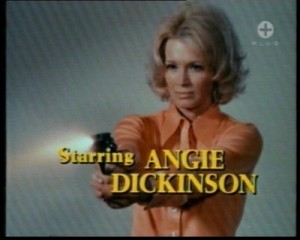 Most of us tend to think of Angie Dickinson when we think of police women — and it’s not just because she was Sgt. Suzanne “Pepper” Anderson on Police Woman in 1974.
Most of us tend to think of Angie Dickinson when we think of police women — and it’s not just because she was Sgt. Suzanne “Pepper” Anderson on Police Woman in 1974.
Most of us tend to think of the 60’s & 70’s when those women’s libbers pushed and sued for the opportunity to be equals (including police officers) and Angie baby was in full mod swing then, so naturally we “see” her as the face (and bod) of the mod we’ve-come-a-long-way-baby policewoman. And the plethora of Police Woman dolls & toys — like this ridiculous “Sabotage Under The Sea” set with octopus — helped solidify this image for a lot of us.
But in truth, there not only were female cops before then, but they were the result of what we’d now call “unlikely feminists” — and some bad male behavior. These battles would be more dangerous than tangling with an octopus.
You may have heard of Isabella Goodwin, the first US woman detective appointed in New York City on March 1, 1912 (it’s the sort of “fun historical fact” people like to blog about, say, on March 1st). But few take the time to give you some real information about her — or at least some cultural context. But you know I’m all about the context, right?
There’s little information available on the web about Isabella Goodwin (save for the fact one-liner), but there is a story & a setting alright.
The story begins in the mid 1800’s when female prisoners were housed with male prisoners and so male officers, their wives, widows of policemen (called “bedmakers,” these women were paid out of the policemen’s own pockets), or “the maid at the police station” performed searches on female prisoners. Such mingling of the sexes shocked the general public — mainly because of the high number of poor men and women who came to New York City often found themselves forced to find shelter at station houses (these people were called “casuals”). According to the NYPD, “in 1887, at various times, up to 42,000 of these homeless women spent at least one night in a station house.” However, things were about to change.
The Women’s Prison Association of New York and the American Female Christian Temperance Union petitioned the Board of Estimate and Apportionment for the appointment of police matrons, and for the creation of separate prison cells for men and women. If it sounds odd to you that Christian women of the 1800’s would be involved in a feminist push for equal career opportunities, you misunderstand. The push was not for careers for women, but for the protection of women who could be victimized by men. And you must remember that once upon a time, Christians saw their role in society as to help the less fortunate, including through social reform, as opposed to the current day philosophy of “”convert them or judge them & leave them to rot.”
Pressured by groups seeking social reforms, the New York State Legislature passed a law requiring that female doctors treat female patients in mental institutions & that every precinct station house has Police Matrons to tend to female arrestees. This legislation was passed in 1888. But the New York City Board of Police Commissioners does not make any Matron appointments until 1891 — after Governor David B. Hill signed a bill that mandated the hiring of Police Matrons and the establishment of separate cells for men and women under arrest. This was a direct result of a police officer being found guilty the attempted assault of a fifteen-year-old girl at a station house and sentenced to prison in 1890.
Months later, the first civil service test was held for the title of Police Matron — with applicants being required to have letters of recommendation from at least twenty women “of good standing.”
In an attempt at humor, I suppose, Jay Maeder sums up the “new” police matrons with “thus creating the jail-matron system that remained a sinecure for many a stern, stout Irishwoman well into the 20th century.”
:sigh:
Maeder’s stereotype isn’t the worst, or even the first. Gilder Lehrman Institute of American History notes:
Of course the matrons were not installed without criticism, which by the way ranged from the prediction that women would become totally incapacitated at the sighting of a mere rodent to criticism that men wouldn’t stand a chance because women would completely take over, dominating the station house and their fellow male employees.
Police Matrons worked long hours, receiving only one day off per month, and just one week’s vacation per year. In 1896, there is one Matron per shift (one day, one night) per station house. Their duties increase too. Matrons are now assigned to search subjects; process, escort and supervise inmates; and to care for lost children. As of 1899, they were paid $1,000 per year as of 1899, and they would not receive a pay increase until 1918.
It is in 1896 that police widow Isabella Goodwin (noted as having four children) is hired as a Police Matron and begins her police career, which will culminate in making First Grade Detective in March of 1912, and being appointed second in command of the first Women’s Police Precinct in April that same year.
Goodwin’s appointment to detective came about through the Police Chief bypassing Civil Service requirements that discriminated against women — presumably in large part due to pressure from the public and lots of press regarding her role in “bringing to justice of the taxicab bandits,” as evidenced in Goodwin’s interview in The New York Times, March 3, 1912 (below).
You really should read it; where else can you read a real news story which includes characters called Swede Annie and Eddie The Boob?
The old newspaper article also includes Goodwin’s story of a bust of a (male) fortune teller. The problem of $2 readings were apparently quite prevalent, for The New York Supplement details of Goodwin’s testimony & the judge’s affirmation of the conviction of fake fortune teller Maude Malcolm on Janurary 18, 1915 (beginning on page 919).
Goodwin, naturally, ends the interview with a, “Despite my peculiar work I try not to neglect my home. A woman’s first duty is to her family, and I have tried always to remember that.” To which the author is only too happy to pander, prove (with assertions from Isabella’s children & the author’s own eyes) & compliment.
But if this seems, well, less satisfactory than the loud “long way baby” route of the mod 60’s women’s lib ladies, consider the following…
Such public adoration may have been new to Goodwin and to female policewomen at the time, but Jay Maeder notes it wouldn’t stay that way:
Matrons did women pretty much exclusively until 1912, when one Isabella Goodwin, theretofore detailed to the wayward-lass wing of the Mercer St. station, was assigned to take a position as a domestic in a household full of suspected bank robbers. Goodwin, swiftly getting the goods on this bunch, then became New York’s first female detective first grade. Subsequently, more and more women began to get pulled into crime-busting duties, and a full-fledged Bureau of Policewomen was established in 1926.
The city’s lady cops, many of them nurses and lawyers and social workers and other such college-educated professionals, were celebrated public figures all through the 1930s and ’40s and ’50s, always good press copy as they went often quite dangerously undercover to lure sexual predators and smash abortion rings and whatnot.
Isabella Goodwin may never have had a doll or octopus made in her honor; but then again, she was probably never called “a bitch of a detective” in some sort of twisted praise. Angie Dickinson, on the other hand, only played a detective on TV and got the doll, the octopus, the pinup poses in men’s magazines, and had her then-husband, Burt Bacharach, “compliment” her by saying, “”If she’s down a notch from me in the public eye these days, well, she should be up a notch—she’s a bitch of an actress.”
So I ask you, who was the more respected woman? Who should we think of when we think of “police woman?”
And why hasn’t someone made a collectible Isabella Goodwin doll?
Maybe instead of an octopus accessory, it can have a fake fortune teller accessory kit.
How To Make Yourself A Black-Faced Negro
From Max Factor’s Hints On The Art Of Make-Up, Booklet No 5: Popular Stage Types (23rd edition, copyright 1961), instructions for “black-face comedians” to become The Negro. Part of my vintage boxed Max Factor “Male Stage Make-up Kit” for students set.
History Is Ephemeral Carnival, 2nd Edition
 Welcome to the second edition of the History Is Ephemeral Carnival, where “old paper” is more than just an obsession or a fire hazard — it’s the stuff of discovery.
Welcome to the second edition of the History Is Ephemeral Carnival, where “old paper” is more than just an obsession or a fire hazard — it’s the stuff of discovery.
Azrael Brown presents The Big Book of Cattle Brands posted at Double-Breasted Dust-Jacket.
Tattered & Lost presents When bluebirds fly over 4 leaf clover YOU’LL FIND A PIANO SALESMAN posted at Tattered and Lost Ephemera.
Frank presents Rare laser & holography art exhibit posters from the 80’s posted at HoloWorld at YouTube.
J.W. presents Victorian Beauties posted at The Collective Picture, saying, “A blog that collects photos and talks about their significance. This post is about the history of photography, and show’s early images of Victorian woman.”
Cliff Aliperti presents The Sporting News Coverage of Lou Gehrig Surpassing Everett Scott’s Record posted at VintageMeld.com.
I present When Does It Become Too Hot To Operate A Model Railroad? (Or, Taking A Ride On A Model Train To Meet The Emperor of Death Valley) posted here at Kitsch Slapped.
Azrael Brown presents Helen and Mrs. Faucher in blackface posted at The Infomercantile.
J.W. presents Tobacco Floats, Prize Goats and Billy Bowlegs posted at The Collective Picture.
Tattered & Lost presents Where have all the FLORIST SHOPS GONE? posted at Tattered and Lost Photographs.
Love old paper? Found something interesting? Please, submit your blog post/article — or one you like — to the next edition of history is ephemeral using the carnival submission form.
Past posts and future hosts can be found on the blog carnival index page. (If you’d like to host, just let me know!)
Technorati tags: history is ephemeral, blog carnival.
When Does It Become Too Hot To Operate A Model Railroad? (Or, Taking A Ride On A Model Train To Meet The Emperor of Death Valley)
When does it become too hot to operate a model railroad?
When the thermometer reaches 160 degrees.
So said T.R. Goodwin, superintendent of Death Valley National Monument — and model railroad enthusiast — in that oh-so priceless March 1951 issue of Profitable Hobbies Magazine. (Click to read the large scan.)
But the story doesn’t end there. Well, it probably does for most people; but I’m one of those obsessives, remember? I find one (admittedly amusing) article, and I have to find out more.
(Here’s where I recommend you have a beverage & settle in to read. This 1950’s article about a man and his model train set is better than Mister Rogers’ trolley taking you to the Neighborhood of Make-Believe; Goodwin’s train, said to be the only train for 145 miles — and probably long neglected by now if parts of it even exist — takes you back in time.)
While the heat standard for model railroad use set by Goodwin in 1951 should speak for itself, the official hottest temperature recorded for Death Valley is listed as 134° (in July, 1913, at what is now Furnace Creek Ranch). But, that really doesn’t matter much to me; frankly, when the temp reaches 125, most all of my hobbies would cease — as would my breathing, probably. Anyway, I was now left to research T. R. Goodwin himself.
The short article in Profitable Hobbies Magazine says that “Mr. Goodwin opened Death Valley as a national monument under the jurisdiction of the National Park Service in 1933. Since that time he has watched his barren domain grow rapidly in importance as a tourist attraction.” So I thought there would be a rather large amount of information on Goodwin. But I was wrong.
It’s disappointing to find so little on Goodwin; not just because I’m obsessive, but because from what I can piece together, the man plays important roles in US history. And why shouldn’t he? As Superintendent of The Death Valley National Monument, T.R. Goodwin, was called “Emperor of Death Valley” in Harry Oliver‘s Desert Rat Scrap Book (Packet Three, Pouch Four, 1950, page 3, “The Mail Pouch”), saying, “Though his majesty rules an area larger than some of our states with considerable more power than any Governor, it is whispered that his highness has to swat his own Vinegarones and take his own pet tortoise out for a run.”
Homey & humorous, yes; full of yesteryear’s non-pc protocol, sure. But knowing that Goodwin was in charge of nearly two million acres, you have to consider the truth of it too.
While the discovery of the Desert Rat Scrap Books (which are full of charming & inappropriate old stories — including many attributed to Goodwin) would be a delightful enough conclusion (or, more accurately, a lovely collection pursuit), there is far more. If you are willing to devote hours, days to researching Goodwin. And I am. (Need to replenish your beverage yet?)
At first the info is sketchy. The “T.R.” in T.R. Goodwin stands for Theodore Raymond Goodwin. He served in the Spanish-American War, lost his first wife after just a few years of marriage, and RootsWeb says that T.R. Goodwin was the brother of noted western artist Philip R. Goodwin.
There’s a Death Valley ’49ers “Keepsake” booklet on T.R. Goodwin, published in 1978 — but apparently long out of print. (I’ve ordered a copy & will share what I can.)
Until I get the book, this is what I’ve been able to piece together.
While Goodwin may have been the first official superintendent, his gig didn’t start until 1938, according to the National Park Service. Officially, the Death Valley National Monument was established by President Herbert Hoover on February 11, 1933 and John R. White was the acting superintendent, starting on March 16, 1933, until April 14, 1938; then Goodwin took over on April 15th as the official superintendent.
According to NPS administrative history information, Goodwin seems to have appeared on the government parks scene sometime prior to 1928, when he was the director or roadwork done in the Cold Spring, Anna Spring Plaza, Anna Spring Dam, and the Rim Village area.
Three park roads received surfacing/oil processing treatment in 1928 under the direction of T.R. Goodwin, a road oiling expert loaned to the National Park Service by the California State Highway Commission.
Goodwin must have loved the area & the people, because before he was established as superintendent Goodwin wrote an article (“Park Ranger Believes Early White History Lies Behind Sealed Lips of Red Man Of The Desert,” Inyo Independent, 29 October 1937) on the Indians of the region, “and in so doing attempted to delineate some of the relationships.” He & his writings on Native Americans was written about as well. Perhaps care & concern for the people and land is what got him the superintendent gig rather than his construction skills — or willingness to put up with the heat of Death Valley.
Among the John P. Harrington papers (from 1907 – 1959) held at the Smithsonian Institution, are letters between Harrington, the American linguist and ethnologist who specialized in the native peoples of California, and Goodwin. These letters, dated May of 1946, show Harrington preparing for a field visit to study the Death Valley Indians.
JPH to Goodwin, May 11, 1946:
The writer is Ethnologist in the Bureau of American Ethnology, Smithsonian Institution, and wants to make a study of the Death Valley Indians. I understand that the Indian Village in Death Valley is 30 miles from your Park Headquarters – in which direction and how reached? Is this village at Death Valley Junction? Any information that you give me will be greatly appreciated. It may be that it is too late in the season to visit this Village for I am told that the Indians of it repair to remote places in the mountains during the summer months. I could come in the fall. There must be some Indian who would be a good interpreter or informant – what is the name of such a one, or better the names of several. They say that only the northern part of the Panamint Mountains belonged to the Death Valley Indians, that is, to the Shoshoni Indians, and that the southern part of the Panamint Mountains belonged to the Chemehuevi Indians. That would make it that there are two languages spoken at the Village. Or has the Chemehuevi language retreated – to where? Where was the line? Or was it the Serrano language of the Tehachapi Mountains instead of the Chemehuevi language? Who were the Panamint Indians – did they talk Chemehuevi? Who were the Pitant Indians? Who were the Keits Indians?
Goodwin to JPH, May 15, 1946:
With reference to your letter of May 1[1], 1946…
Most, if not all, the Indians move to the high country in the summer returning after gathering pinon nuts in the early fall. Practically all the males speak good english and one in particular Tom Wilson who is half breed Piute with a Mexican father, is married to the daughter of the former Chief Hungry Bill. Tom is intelligent and speaks excellent english.
I have never heard of any territorial division of the Death Valley Indians. They are supposed to be an off-shoot of the Shoshone tribe. . . . The Death Valley Indians are called Panamint Indians and all live here except for a few around Beatty, Nevada and one family in the Panamint Valley. They are not wards but are under general supervision of the Carson Agency at Stewart, Nevada. All the other Indians I know of surrounding the area are Piutes and said to be tribal enemies of the Panamints.
JPH to Goodwin, May 20, 1946:
Your extraordinarily kind letter, full of information, has arrived and I am surely glad that I wrote you before coming. Several of the matters that you state perplex me.
A Chemehuevi (Piute) Indian told me that the Panamint Indians speak the Piute language; that the northern part of the Panamint Range was held by another kind of Indians, an off-variety of the Shoshones, whom a Panamint Indian can not understand; that way north of these quasi-Shoshones there lives another kind of Piutes known as the Northern Piutes, who speak another non-intelligible language — that same one that is spoken by the Bannock Indians, in southern Oregon, at Carson City, Nev., at Bishop, Calif., etc.
Thanks a million times over for telling me about Mr. Tom Wilson – is he still at Furnace Creek? How could I write to him? He would perhaps instantly know about this Shoshone-Panamint mix-up. Isn’t there any place that one could board at Furnace Creek though the Inn is closed? It may be going to require Indians to straighten this matter out. . . .
Goodwin to JPH, May 27, 1946:
Replying to your letter of May 20, 1946, you apparently have certain information that has never been brought out here, although we have had close touch with the Indians in this vicinity over a period of thirteen years. . . .
While there’s a certain level of condescension in referring to a “half breed” as “intelligent,” one must remember that in 1946 “Injuns” had it far worse. It was a different time & place, and Goodwin was living in The West, among such characters as Walter Scott aka Death Valley Scotty, one of the rough-riders for the Buffalo Bill Wild West Show turned prospectors who built Scotty’s Castle.
Tribute to Goodwin’s own intelligence can be found in history books: He is called “a more sympathetic Park Service official” in Forgotten Tribes: Unrecognized Indians and the Federal Acknowledgment Process by author Mark Edwin Miller, and in Death Valley (Images of America: California), author Robert P. Palazzo says Goodwin was “instrumental in taking up the cause of the Timbisha to prevent their removal from the monument.”
In the correspondence between Goodwin & Harrington, I am particularly amused by the polite perplexed assertions each professional makes as they defend their information about the Timbisha Shoshone people; especially how Goodwin, a former road oiling man turned government administrator, holds his own against Harrington, the bookish linguist and ethnologist.
Gawd – I love old letters like this.
But Goodwin’s story doesn’t end here either.
During World War II Japanese-Americans had it as bad as Native Americans. Not just racist Asian humor, but in removal from their homes. Ten camps on US soil imprisoned over 110,000 Japanese American citizens and resident Japanese aliens during WWII — one of which was Manzanar. A place already with a long history of forced relocated peoples. (I swear my history books & lectures never really imparted this knowledge to me; nor had I ever grasped the concurrent plight of Japanese Americans & Native Americans. And, if that doesn’t blow your mind, consider that Ansel Adams was at Manzanar taking photographs.)
In December 1942, a riot broke out at Manzanar War Relocation Camp. This became known as The Manzanar “Incident.”
On December 6, 1942, one of the most serious civil disturbances to occur at all the relocation centers erupted at Manzanar. Months of internal tension and gang activity had raged between members of the Japanese American Citizens League (JACL) and many of the first-generation Japanese. Although the JACL leaders acted as representatives to the administration, the elders did not share their views and had little respect for them. Meetings turned into shouting sessions with beatings and death threats against the pro-administration group.
On the night of December 5, six masked men beat JACL leader Fred Tayama while he was in his bed. The leader of the Kitchen Workers Union, Harry Ueno, was arrested for the beating and jailed in the nearby town of Independence despite a lack of conclusive evidence. The next day about 2,000 internees gathered in support of Ueno, and a “committee of five” was selected to negotiate his release. Center Director Ralph Merritt attempted to talk with the agitated crowd and subsequently agreed to bring Ueno back to the relocation center jail to avoid further violence or bloodshed.
…By evening, the soldiers who were stationed in front of the building drew a line in the sand but the hostile protesters surged closer. The crowd became extremely unruly and tear gas was used to break up the demonstration. Although no orders were given to shoot, soldiers fired into the crowd, and a 17- year old was killed and eleven others were wounded. One of the wounded died later on December 11.
Protesters who were considered troublemakers were removed from the camp and held in local jails. Those who were U.S. citizens went to a WRA isolation center at Moab and non-U.S. citizens were sent to Department of Justice camps. Most work, except oil delivery and kitchen crews, was suspended by the administration until after Christmas. By early January 1943, the camp’s operations fully resumed, and schools reopened on January 10.
But what of Tayama & others who were attacked and threatened? Here’s more of the story of Manzanar:
On Sunday night and Monday, December 6 and 7, threats were made against many evacuees at Manzanar who were outspoken pro-American advocates or who were perceived to have pro-WRA administration sentiments. Those threatened included staff members of the Manzanar Free Press, members of the internal security police force, and evacuees who had supervisory jobs in the center. Many of these evacuees, including Tayama, Tanaka, and Slocum, had been active members of the Japanese American Citizens League prior to evacuation, and many had encouraged evacuee cooperation with the government’s relocation policies. John Sinoda, a 25-year-old Kibei who held a key position in the camp’s employment office, was severely beaten by a gang with clubs at the outdoor theater, receiving scalp lacerations. Others were assaulted, including George Kurata, the camp housing coordinator, who managed to escape from his attackers. [49] By Monday noon, approximately 40 evacuees had entered the camp Administration Building, asking for protection and indicating that they were afraid to remain in their barracks. The administration also aided removal from the barracks those evacuees whose names appeared on the dissidents’ blacklists and deathlists. Thus, the number of evacuees taken into protective custody by the camp administration subsequently increased to 65 individuals.
The evacuees in protective custody slept on cots in the Administration Building at night and were crowded into a room in one of the military barracks in the military police compound south of the camp during the day. There was insufficient room for all of them, however, and they were forced to take turns “in getting warm.” They were fed in the kitchen in the military police compound. [50]
Faced with the dilemma of protecting the 65 people, Merritt and his staff immediately began a search for a place outside of Manzanar to house them on a temporary basis. Merritt and Brown had been associated with T. R. Goodwin, Superintendent of Death Valley National Monument, during their days with the Inyo-Mono Associates as well as the Citizens Committee established by the military to ease public relations for the camp with the Owens Valley residents following evacuation. Thus, Merritt sent Brown to Death Valley to inquire as to whether the national monument had any place to house the people. Goodwin offered the abandoned Cow Creek Civilian Conservation Camp, comprised of 16 deteriorating buildings adjacent to the monument’s headquarters. After considerable discussion and clearance was received from WRA Director Myer and General DeWitt, the 65 evacuees, who became known as “refugees,” were sent to Cow Creek on December 10.
…The Cow Creek camp was administered by Camp Director Albert Chamberlain, a WRA employee, and Fred Tayama was elected unofficial “mayor” by the refugees. The WRA staff, evacuees, and soldiers shared the same latrines and showers and ate at the same times in the mess hall which was supplied from Manzanar. After improving their quarters and the grounds of the camp, the evacuee men, needing something to do with their time and appreciative of the hospitality shown by the National Park Service, painted signs, cleaned out springs, built dams, dug ditches, mixed cement, installed radio antennas, and conducted other odd jobs in the national monument without pay. The evacuee women spent their days, caring for their children, assisting in the mess hall, and housekeeping. During their stay. Park Service personnel, as well as the soldiers, took groups of evacuees sightseeing in the national monument and on trips to pick up supplies and mail. The camp had a swimming pool that was enjoyed by the older children. The 65 evacuees remained at the Cow Creek camp under military guard, primarily for their protection, until arrangements could be made for their release through indefinite leave and assistance could be provided for relocation. The American Friends Service Committee played a major role in obtaining jobs and homes for the evacuees, sending representatives to Cow Creek to interview and assist them in planning for relocation. As a result of this organization’s efforts, many of the evacuees relocated to Chicago where the Friends had established a hostel to help those relocating from the relocation centers. As jobs and housing became available, departing evacuees were taken to Las Vegas, the nearest railhead, via military escort. By mid-February the “refugee” camp at Cow Creek was vacated. [51]
I wonder if any of the group of 65 Japanese and Japanese American internees brought into Death Valley for their safety got to see or play with Goodwin’s model railroad?
Is this the end of Goodwin’s story?
It is unclear. For while little else could be found about him, it seems unlikely that such an active man would just wither away, content to be a relic of the past. He must have been more than just a fascinating old coot, with lots of stories to share (should anyone be willing). But for now, I have nothing but blanks.
T. R. Goodwin died in 1972; this I learned from his wife Neva’s obituary, which also lists Mr. Goodwin as “an engineer in Sequoia” prior to placement as superintendent of the Death Valley National Monument. This may not be so accurate. Other research, again tied to Neva Goodwin’s death, states that T.R. Goodwin died in 1969:
T. R. “Ray” Goodwin preceded her in death Oct. 27, 1969. Research Note: Stone reads that he died Oct 25, 1969.
It’s interesting to note that while Mr. Goodwin was an amazing man — one I think ought to be remembered — that his wife’s obit mentions next to nothing of her own life. This sexist fact is noted by Cathy Spude in her discussion of Mrs. Goodwin’s obituary, as published in The Electric Courier, and electronic newsletter for the employees of the National Park Service:
September 11, 1996 Volume 2, Number 13
“Neva Goodwin, 100, died August 14 at the home of her daughter, Kay Hamblin, in Yreka, California. She was buried in Monett, Missouri. Mrs. Goodwin was the first superintendent’s wife to live in Death Valley. T.R. Goodwin had been an engineer in Sequoia when he was put in charge of the newly created monument in 1933. He also served in Yellowstone, Yosemite and Grand Canyon during his NPS career. He died in 1972. Memorial donations in Mrs. Goodwin’s name may be made to Waldensen Presbyterian Church in Monett, MO 65708. Survivors include sister Chris Driskill, daughter Kay Hamblin, son Ted Goodwin, five grandchildren and one great-grandchild. Contacts with the family may be made through the Death Valley public affairs office.”
So we see that gender-based stereotypes in obituaries is not confined to the late 19th and early 20th centuries; it is here in 1996! It appears, from this obituary, that Neva Goodwin’s primary contribution to society was through her roles as wife, sister and mother. More information was given about what her husband did in his career than about Neva in her career as wife and mother.
The editor of this newsletter would probably be defensive if I suggested that his obituary was androcentric; he would no doubt reply that the readers of the newsletter are more interested in fellow employees (i.e., the deceased’s husband) than in their spouses. I wonder how many people in the service do indeed remember a man who died in 1972 (my 21-year career post-dates that event). Neva without a doubt continued to contribute to something at Death Valley, that the public affairs office is handling contacts with the family. What that contribution was, we cannot tell from this obit.
Surely as his wife, living with him in Death Valley, Neva Goodwin had her own work — and stories as well. She must have raised their son (the very one, according to the original 1951 article, the first of T.R.’s toy trains was purchased for). And, I imagine, Neva spend many a night trying to get Superintendent Goodwin to stop playing with his toy trains long enough to get something to eat & sleep before he began he’d have to get up in the morning and become Emperor of Death Valley again.
Solving My Own Nerdy Needs
I have two problems when I turn to Google or any internet search engine: one is what’s missing, and the other is that I don’t know about something in order to find it.
The first issue is a problem with my obsession with researching my collectibles. So many times I hold something in my hand, but according to Google (and all the search engines & online archives I try) it doesn’t exist. You’d think with the number of times it happens, I’d no longer be surprised; but I continually am. And I also get frustrated. But eventually my compulsive need to know makes me get off my butt and head to libraries and make calls to institutions with specific archives and collections — and then I write about it online.
Yeah, I’m doing my best to stuff the internet with knowledge I wish already existed on it.
I do hope the other obsessive compulsives appreciate that.
The second issue is that when I don’t know that things exist (and that happens — because no matter how much hubby and I cram into our house & heads, we neither have everything nor know everything), how can I search for them?
I’m always on the look out for out of print books and vintage magazines & other publications to read. I love watching old movies, playing old boardgames, taking road trips to kitschy roadside attractions, and the like. But if I don’t know these things exist, how can I find out about them? And with folksonomy being a combination of “the personal” and “randomness”, who knows what keywords, tags &/or labels others would use to classify them?
I try, don’t get me wrong; but I end up with more unwanted stuff than a litter box.
To help myself — and those nerds like me — I’ve started two blog carnivals: The History Is Ephemeral Carnival and The New Vintage Reviews Carnival.
Please support the carnivals by submitting your posts/articles &/or those posts/articles by others, by informing you favorite bloggers who are equally nerdy, and by coming back to see the carnival goodies!
Don’t Expect To Find Help Making That Penis Quilt At Jo-Ann Fabrics
Apparently, the March/April issue of Quilter’s Home magazine was “too hot” for Jo-Ann Fabric and Crafts — at least that’s what they told the distributor for the magazine when they refused to carry the “controversial” issue in their chain of stores. This after editor/owner Mark Lipinski had paid $2,500 to wrap some 45,000 copies in plastic like a porno mag.
Why so much fuss about a quilting magazine? Because the publication dared to include Shocking Quilts, an article by Jake Finc.
The shocking quilts include Gwendolyn Magree’s Southern Heritage/Southern Shame, a quilted response to Mississippi’s refusal to remove the confederate flag from the state flag (which shows lynching), and Mary Beth Bellah’s Helping Hands, which is apparently a cheeky representation of erectile dysfunction — complete with a hand and little blue “pills” made of fabric, a couple of which have actual penises printed on them.
These quilts are the very definition of art — not just something made by hand, but unique works exploring issues of our society. You remember art, don’t you? It’s one of the ways people communicate & exchange ideas, start dialogs. Well, Jo-Ann will have none of that.
Please confine your creativity to the kits provided.
Oh, bother. I thought that with Bush banished from the White House, censorship would move back into the hands of individual consumers. You remember them, right? People who choose to buy — or not to buy — based on their own particular set of values.
But Jo-Ann feels the need to protect us from ideas & creativity.
…Hmmmm… Doesn’t that seem to be against the mission of an arts & crafts retailer?
Let’s see. This is what the company has to say for itself:
Today, Jo-Ann Stores, Inc. is a leading national specialty retailer of crafting, decorating, and sewing products-a “Create-It-Yourself” Superstore. We sell fashion and decorator fabrics, related notions, patterns, crafts, seasonal products and other merchandise. We sell the components to which our customers add their own talent and time to make fun and exciting projects. We are the only fabric and craft retailer that offers creative people everything they need-the products, the assistance, and the inspiration-to fulfill their creative dreams.
So what if my dreams include penis-print fabrics? What if my exciting project explores racial history, or otherwise doesn’t share your CEO’s political philosophies or religious leanings?
I guess then I’d need to shop elsewhere.
I could just let that irony be the last nail in their coffin, let the marketplace speak & pronounce the chain dead for such a stupid thing — because I and millions like me won’t shop there anymore. I personally have a Hobby Lobby and a Michael’s — both well-stocked. As well as an internet full of other options. I urge all readers to use any of them rather than Jo-Ann Fabric & Craft Stores.
But I don’t think that’s enough. I think we all need to support Lipinski and Quilter’s Home, let them know that we appreciate the coverage & support of creative artists & atypical projects — and the best way to do that is to subscribe. Yes, even if you don’t personally quilt; give it as a gift.
Or better yet, keep the mag & dare to be inspired to make your own radical quilts.
I’m A Little Late To The National Cleavage Day Party
I didn’t know that there was/is such a thing as National Cleavage Day. If it weren’t for Denise‘s post about it at BlogHer, I still wouldn’t know about it. And if I had somehow stumbled into the Wiki page about NCD, I would have thought it was something Steven Colbert had directed his Colbert Nation minions into creating. (Seeing “corporate sponsor” Wonderbra’s page on NCD wouldn’t have helped either; the power of Colbert is boundless.)
But I’m not only late to the party — I’m a National Cleavage Day party pooper too.
Now it may surprise you that I’m not really a fan of National Cleavage Day. You’re likely thinking that as a collector of smut, not to mention the owner of a rack that would require the jaws of life not to make cleavage, I’d be in favor of a day which celebrates cleavage. But I’m not.
Call me jaded by the decades of leers & drool, accuse me of being exhausted and annoyed from the countless times of having to hold strong chiseled male jaws in my hand and tilt them, like that of a small child, so that their owners may speak to my face and not my breasts; I am. But really, do we need to encourage men to stare at women’s breasts?
Oh, sure, if you’re at a bar or club or other place where you are participating in and exploiting nature’s call to preserve the species, by all means, show it off. And I’ll admit that while those days of hunting-til-he-catches-me are over for me, I’m not above bringing out The Girls to remind me, myself, and hubby that I’m a sexy desirable woman — all the leers, drool and jaw tilting keep any need for Cialis at bay. But I don’t display ’em at WalMart. Or because a corporate sponsor told me to.
But a day for cleavage watching? Like a Take Your Boobs To Work Day? A Shake Your Boobs At Work Day? Or Super Casual (& Smutty) Friday? Puh-leeez.
I’ll guarantee you that the girls (lower case here because we’re now talking about a group of young females, not my breasts) who participate in this “holiday” are “third wave feminists” who think that proffering crevice, tit or ass (via whale-tails etc.), is akin to rolling down one’s stockings: an advance for female equality. Only, see, we don’t allow men to show pecs and gluts in public either — and that means we don’t see their cracks between such flesh in the workplace either, hun. That’s equality.
If I sound like a crotchety old anti-porn feminist, know I’m not. (If you want proof, I’ll send it.) But I just get so frustrated with the lack of class. Leave a little mystery, damnit. And save the intimate visuals of intimate spaces for intimate times & intimate places.
And as for you, Wonderbra, shame, shame, shame on you.
If Wikipedia is to be believed, the “corporate sponsorship” is intended to be as uplifting as the Wonderbras:
According to Samantha Paterson, the brand manager for Wonderbra, the National Cleavage Day is started according to a design to solemnize women’s independence and power in all facets of life, from their careers to their relationships to their own destiny.[1] Anita Meiring, public relations consultant for Wonderbra, explained the event, “It is a day for women to realise that their cleavage is something unique and that they should be proud of it”.[4] Paterson explained “It gives women a chance to be beautiful and glow in the furtive, yet appreciative, glances their cleavage evokes from men”.[1] She also explained “It gives men a legitimate reason to stare at boobs”.
Just how does one “solemnize women’s independence and power in all facets of life” by proffering exposed breast? And hey, Meiring, I completely realize that my cleavage is “unique” and I am “proud of it” — but I know (at least) two things that apparently you don’t.
One, this ain’t Utopia, sister; women who expose themselves in public are seen as “asking for it” and that puts us in danger twice (first for being assaulted, and then at the mercy of a court who holds us and our mode of dress responsible for male actions).
Two, my pride isn’t dependent upon flashing it to prove it to you, to leering men, or to anyone/everyone else. Confidence just is.
Quietly just is.
And that’s the way I like it, especially in public.
I’m not asking for the burka, baby; just some rational acceptance of public decency as reflective of both no need to push my privates into public spaces and people’s faces and my desire to not see every body part others are proud of. That’s what manners are all about, making people feel comfortable. Can ya dig?
In reality Wonderbra is pimping: they’ve created a faux holiday through which they can use sexism to profit off of the display of female bodies — selling women and sexist misogynistic fantasies under the guise of pride.
The final nail in National Cleavage Day’s coffin is the fact that Cosmo supports it. Again, from the suspicious Wiki page:
Vanessa Raphaely, editor of the Cosmopolitan, argued the NCD is not intended to objectify women, but to celebrate in a fun manner.[4]
Cosmo hasn’t been accurate about women’s rights & male responsibilities since the 60’s — if then. So pooh on that.
It is sexy to feel like you are in control of your beautiful bodies, ladies, but the realities are that even here in the US of A we women are not in control of our own bodies — but we are somehow responsible for male reactions to our bodies and, in cases of rape (for rape is all about rage & power, not lust & sex), we are somehow responsible for that too. And when women are harassed and abused for busting with pride and showing off their cleavage, you know what will happen.
Oh, it’s a mess out there, Virginia. And while I’d like to let you boldly go forth, displaying your confidence laden cleavage, I know better.
Naughty Secretaries Vs. Bosses Gone Bad
The myth of the naughty secretary was created & used to perpetuate fears among Victorian housewives, who, as the arbitrators and guardians of morality, were thought to be able to dictate who took dictation via two paths.
One path was the ability to hen peck their husbands’ hiring practices, and therefore not have female applicants get picked for the jobs. (Often women would suggest male candidates, as they needed to support families — or have enough income to get married.)
The other path was to pressure their ‘sisters’ into conforming to womanly virtue. Like their Chinese counterparts, women would bind their sisters’ economic feet — only through lecture, condemnation, and societal pursuit. But women would be hobbled just the same — and, as males preferred, the women would direct their anger and blame at the feet of their sisters. (Like foot binding, this female-on-female action would only further divide the sisterhood of women, fracturing bonds of trust and creating suspicion among women — which only added to resistance of the messages & mantras of moralistic matrons as well as causing the matrons to believe that women who wanted or needed to work were of poor virtue, ready & willing to debase men and even steal husbands.)
Case-by-case analysis of individual hen pecked husbands & women worried into conformity aside, the plan not only failed (as evidenced by more women continuing to enter the work force for years to come), but backfired into male & female belief that women who did seek employment outside of hearth & home were of poor virtue and suitable not only for dictation but dick-takin’.
Of course, the sexually harassed and abused women found little-to-no comfort or assistance regarding their complains in the arms of their sisters; for in their eyes the secretaries were seen as having it coming (if not the perpetrators of sin themselves, seducing men into indiscriminate behaviors).
Insert jokes about naughty secretaries (and naughty maids), such as these vintage French mechanical cards below, which carried the same weight and purpose in the 1950s atomic age as they did in Victorian times. After all, the concerns were the same.
The Baldknobbers (It Ain’t No April Fool’s Joke!)
Flipping through a box of ephemera at an antique mall, I spotted the word “Baldknobbers” in big red letters — who wouldn’t pull that up for a closer inspection?!
In my hands I now held a souvenir book for The Baldknobbers Hillbilly Jamboree Show, “a tradition in Ozark Mountain Country”– the 25th Anniversary Edition.
That was a bit disappointing… I mean with a name like “The Baldknobbers” I had expected something far more pervy. But it turns out that The Baldknobbers Jamboree attraction was Branson’s first country music and comedy show — and are largely credited for the “music scene” (tourist trap) that Branson now is. Apparently the group started back in 1959 when brothers Bill, Jim, Lyle and Bob Mabe began entertaining visitors in downtown Branson on the Taneycomo lakefront. (One can only imagine that this consisted of odd performances and very little money put into hats?)
I could remain disappointed that there’s not enough smut-factor, that the group still exists — that I don’t have something incredibly exotic and rare. But my souvenir program dates to 1984 (which is older than some of you reading here) and it has 11 Baldknobber autographs, including from founders who have passed away. And, it has photos of the “Baldknobber Wheels”, aka old touring buses used by the group — so awesome, I must have that first one!
(Truthfully, it’s those images which made me pay the $5 & rush home to show my Mom — one lady who enjoys kitschy vehicles and “baldknobbers” as much as I do.)
While that’s cool & all, the interesting thing is the very thing which drew me to the old souvenir booklet: the name Baldknobber.
It turns out that the Mabe brothers took the name from an Old Ozarks vigilante group the Bald Knobbers, who called themselves that because they held their meetings on a treeless hilltop or “bald knob”. Those original Bald Knobbers have a long & complicated history, beginning as, according to Wikipedia, “a group of non-racially motivated vigilantes in the southern part of the state of Missouri.”
Non-racially motivated? I cannot look at the Bald Knobbers’ traditional hoods with horns — on dark fabric with light markings for facial features, no less (Gerry Darnell says they wore horned black pillowcases with the eye and nose holes rimmed in orange) — and not see anything other than the horror of blackface. I’m wondering who can?
But apparently the group was borne of the post-Civil War lawless southwest, a vigilante response to murder and other crime that, horrible enough prior to and during the war, went unheeded & grew after the Civil War as fugitives sought refuge in the remote and inaccessible Ozarks region.
The purpose of the old Bald Knobbers was to “correct the lawlessness”, but eventually they became not only increasingly violent, but using their power for greedy and selfish purposes, including killing Anti-Bald Knobbers and those who spoke negatively about the Bald Knobbers — finally becoming home grown terrorists.
While the Bald Knobbers may not have originally been racially motivated, some argue that the group did not dissolve in 1889, but merely went underground after the lynching of John Wesley Bright in 1892 and then members &/or believers became associated/perverted/twisted into the KKK family clan.
All of this certainly takes a funny phrase and makes it anything but funny.
The “full circle” moment for this collector was discovering that I’ve had my hands on this story of the original vigilante Bald Knobbers for quite some time. In some box or other (which I can’t really dig in right now, due to the flood situation here in Fargo), I’ve got at least one copy of Harold Bell Wright’s Shepherd of the Hills, which I’m told covers the Bald Knobbers and this period of United States history:
In 1907, Harold Bell Wright published the novel Shepherd of the Hills which tells about the Ozark area and its’ settlers such as the Ross family. Mr. Wright was afflicted with tuberculosis (consumption) and stayed with the Ross’ while he waited for the White River to recede enough to be crossed. Mr. Wright was a young man seeking his health. He stopped among the hill folks and found peace. He explored Marvel Cave and was amazed with its beauty. He visited each summer for seven years collecting notes about real life events of the people of the area. He stayed in a tent near the Shepherd of The Hills homestead. The experience moved him to set a story-part fact, part legend, part dream. The novel gained popularity quickly and attracted many tourist to see the area he wrote about. The Shepherd of The Hills novel has become a widely read book and had over a dozen television productions and eight movies made from it.
This is a still from the 1919 movie based on the book:
The bottom line is that I now have two reasons to go to Branson: to see The Baldkknobbers (with my mom, so we can steal some vintage Baldknobber wheels) and to see the cabin that Harold Bell Wright stayed in. I had no reason or desire to go before.
So, to re-cap, I paid $5 for a retro souvenir booklet worth so much more: it made me laugh out loud, discover a fascinating history story — one which leads to a book I likely already own (another excuse to read!), and now have a reason to travel to Branson. I call that a good score.
I Rant About eBay
Ambiguous Policies: Many of eBay policies are not very clear. In fact, if you keep hitting reply and asking the same question about a policy, each reply will have a different section pasted in the document for you to read. It seems that the interpretation is open… This is especially confusing when it comes to one area of selling on eBay: Nudity on eBay.
I personally collect, and therefore sell, vintage men’s magazines. All of these magazines are 1940s through mid 1960s. Some of these magazines have nudity, some are pin ups. When I buy these items as estates etc, I often wind up with vintage nudist magazines mixed in these lots or stacks. Some of these are airbrushed, some are not. Now the difference between the two magazines is the original intent of the publishers —
Men’s magazines were sold to men, for the primary purpose of titillation. The nudist magazines were published to promote & educate on the lifestyle choice of nudists. As such, the photos are not designed to be sexual. Of course, there are some pretty nude women in there, but there are also families sitting around the pool, and some less than beautiful people as well…
The men’s magazines are (usually) deemed OK to sell in the Collectibles areas of eBay, just at pre-1980s Playboys are – they are not graphic. But the nudist publications? Oh no, those must go into Mature Audiences. (Which I personally find offensive as there are photos of families & children in them, and they were not – nor are they now – designed to excite sexually. By putting them in Mature I feel that I am doing something wrong, — especially when that category prohibits the sale of child pornography. So much so, it bans the use of the words “children,” “child,” “Lolita,” etc.)
But to place nudist magazines on eBay in the Collectibles category (where true collectors are looking &/or bidding on them), you risk being booted. I know. I have been suspended for a 30 days for doing so.
The only place you can sell them on eBay, inappropriate as it seems, is the Mature Audience category.
Mature Audiences: This category on eBay is a complete mess. In order to keep out minors, who according to eBay policy are not allowed to bid or buy anyway (they cannot enter legal binding contracts which bidding & buying actions are), eBay has a lock on the Mature Audience category.
Sure, it seems benign enough, smart even. But how the process works is that you have to hunt to find the category, then when you click to enter it, you get a warning, and you must agree that you are legal, not offended by adult materials, and not going to hold eBay responsible if you pass out while viewing the items for sale. Once you agree, you have to find your way back to the Mature Audience category, and start again.
It is now, for the first time, that the subcategories will show up. And you must be in that category to do searches – a search for “all of eBay” does not include Mature Audiences even when you are signed in – at least not consistently.
Again, this may not seem like a royal pain, but it is for 2 reasons:
#1 Your agreement is temporary. It wears off, and you don’t know it until you see the restricted warnings again.
#2 This second login often locks you out as a seller. For some reason, their system of Adult Cookies is not compatible with the cookies used for members or sellers. Which means you cannot search for similar items when selling to get comparisons for items you are selling, while you are listing. (Oh, and you cannot do a search for past sales on Mature Audience Items.) All of which makes for a difficult time selling in the category.
Other restrictions on selling adult materials are no “Buy It Now” & no PayPal.
All this for a category which is policed enough for illegal items, such as child pornography, bestiality etc.
The bottom line is, all these restrictions hamper buyers from finding items, as well as deter actual sales.
You might say that eBay has a right to be “a family friendly business.” And yes, it is their right. But frankly, they are happy to take the listing fees & get no sales, aren’t they? That money is as “unclean” as a sales transaction – only more evil as they know what the odds are; it’s akin to stealing.
I personally think they ought to just end the “offensive” categories, and stop the confusion.
For more on eBay’s treatment of sellers of adult items, read here.
Search Engine Strengths
Let’s take a look at the widely excitable ecommerce community & the impact that search engines have…
Each year the ‘holiday numbers’ are big news in the web world. Proof that we exist, I suppose. Some sort of ‘I shop online, therefore I am’ sort of a thing. Legitimizing the strength & position of the internet, as both commonplace tool, and proper place for corporate entity. But aside from that, there is gold in those glittering holiday numbers, so let’s take a look:
According to Hitwise, an online competitive intelligence service, the market share of all U.S. visits to Shopping and Classifieds sites reached their highest weekly levels during the week ending Dec. 11, 2004, reaching 9.73%. This broke the prior record set Thanksgiving week 2004 (9.72%).
And these numbers are, in part, due to search engines.
Of that record setting high week, ending Dec 11, 2004, this is the percent of that traffic contributed by search engines to those shopping sites:
Google 4.26%
Yahoo! Search 2.24 %
MSN Search 0.54 %
“The holiday shopping frenzy is continuing strong on the Web, with search engines becoming ever more integrated,” said Bill Tancer, vice president of research, Hitwise. (And this here is the super important part: ) “While Google dominates overall referrals, it is important to note that the leading search engines vary in their strength to refer traffic to certain categories versus others. Marketers should carefully consider the nuances of each engine in order to maximize their search strategies.”
While all three of the big search engines contribute to the traffic (& therefore sales), they seem to do so differently.
While all three major search engines seem to send to the same categories* they have different areas of strength:
– Google sends a higher share of its downstream traffic to Books, Sports and Fitness, and Music.
– Yahoo! Search is stronger in sending its shopping referrals to Video and Games, Automotive and Classifieds.
– MSN Search sends a higher share of its shopping referrals to Apparel & Accessories, House & Garden and Appliances & Electronics.
What does this mean to you?
It means you may want to rethink your ad campaign on Google if you are in the video or gardening business.
Or it may make you think a bit more about the ‘why’ the numbers are that way. Perhaps the ‘kids’ are using Yahoo! (on their parents’ pc/ISP with those free Yahoo! email accounts), and so Yahoo’s audience is younger…
Who knows? Not me. Yet anyway. But you can bet I’ll be thinking about it!
* The top three downstream retail categories for the three major search engines were Rewards & Directories (mostly comparison shopping sites), Auctions, & Department Stores.
